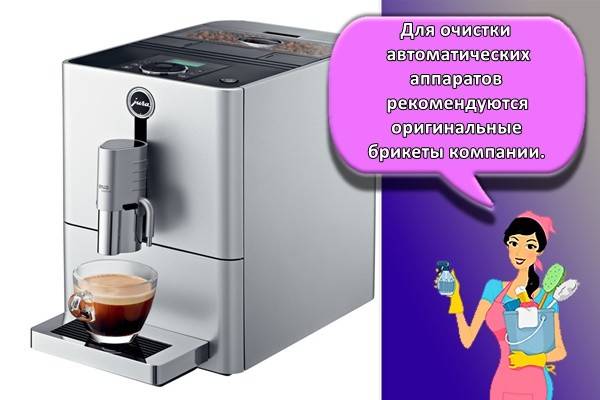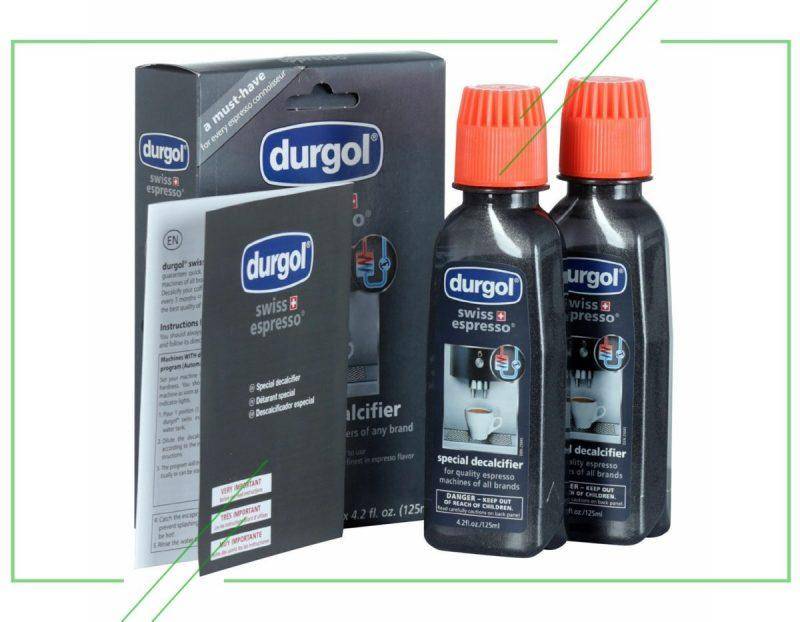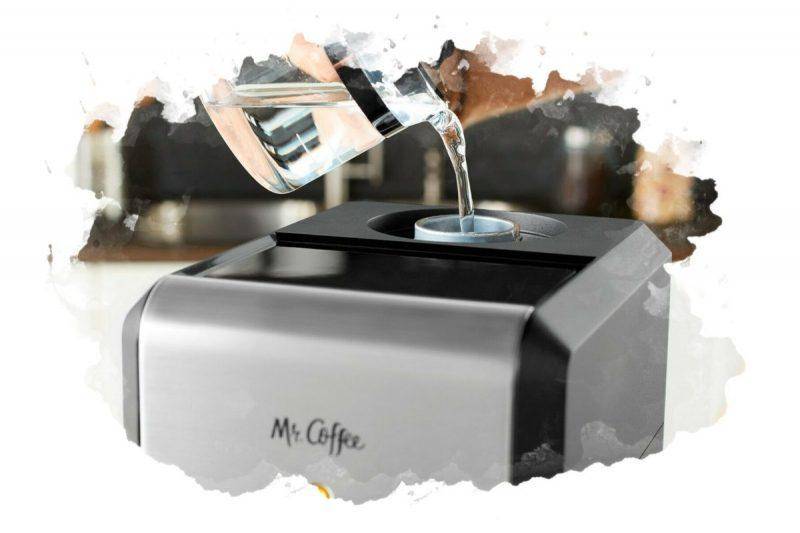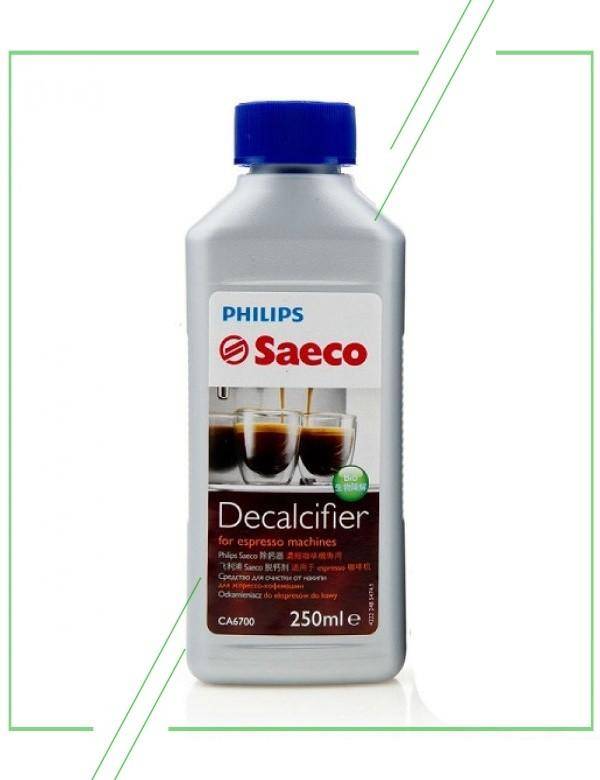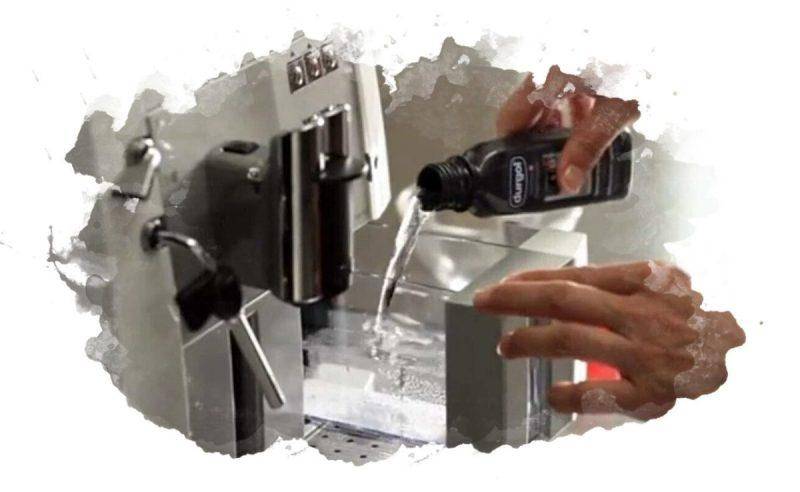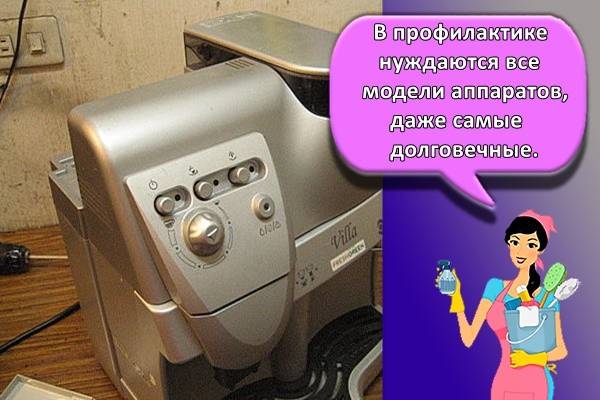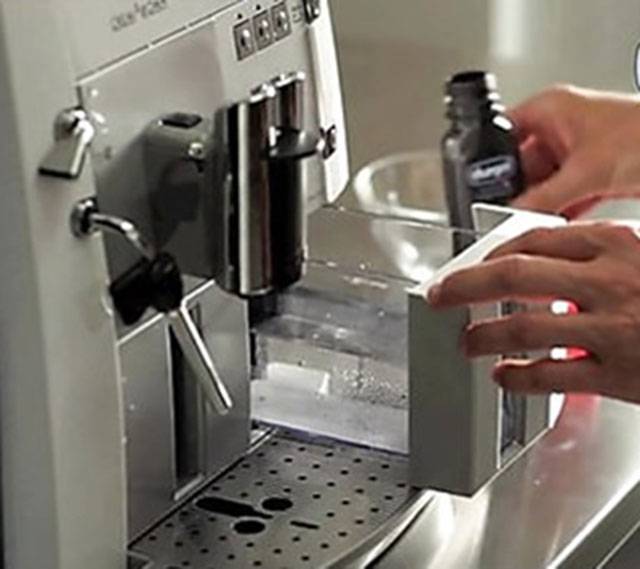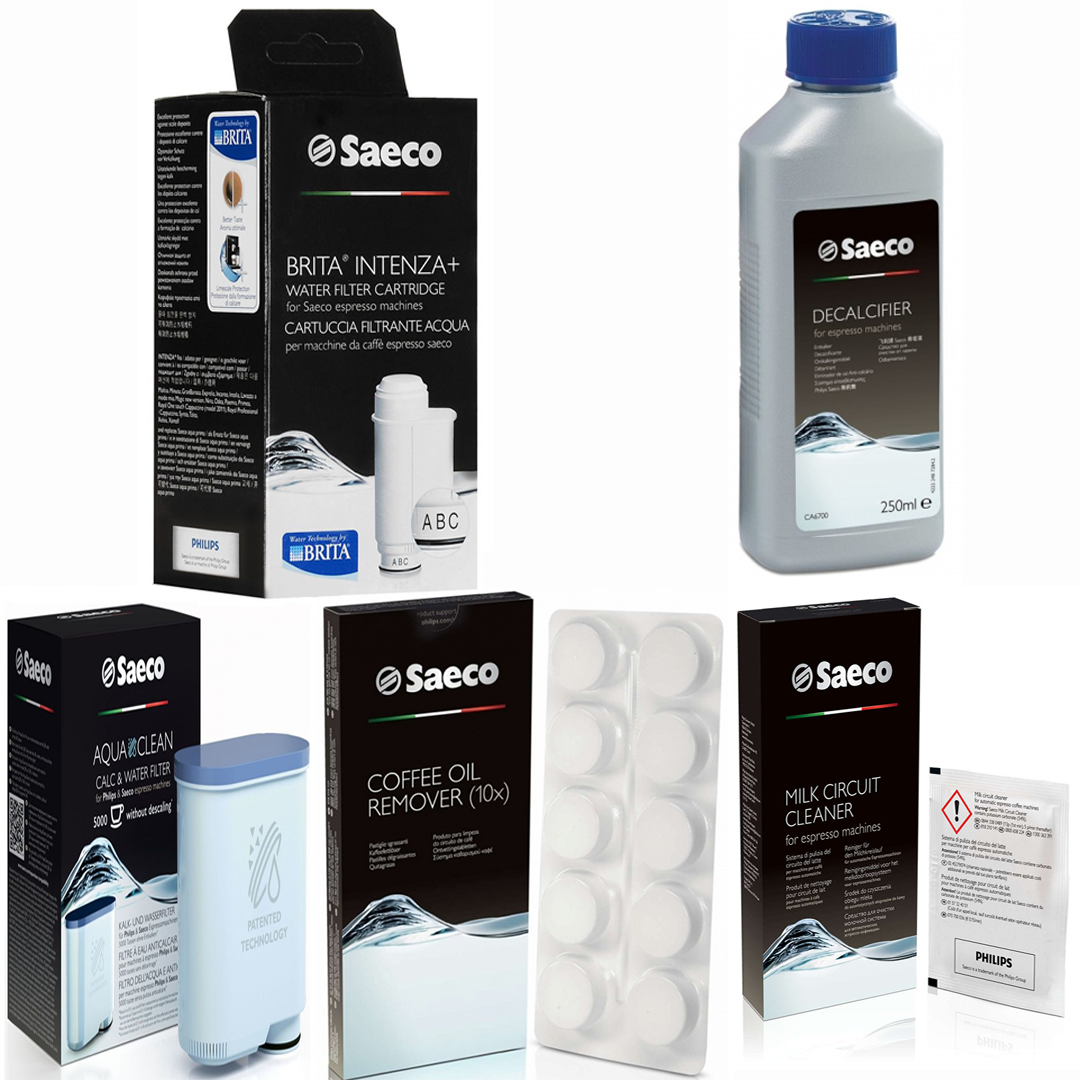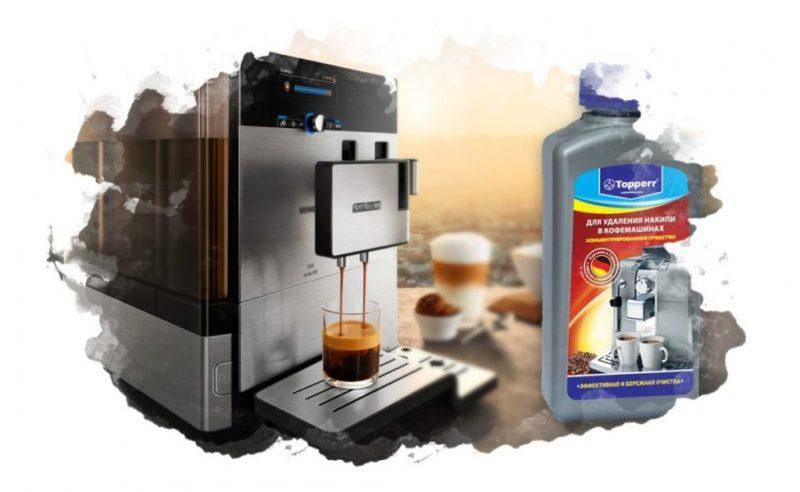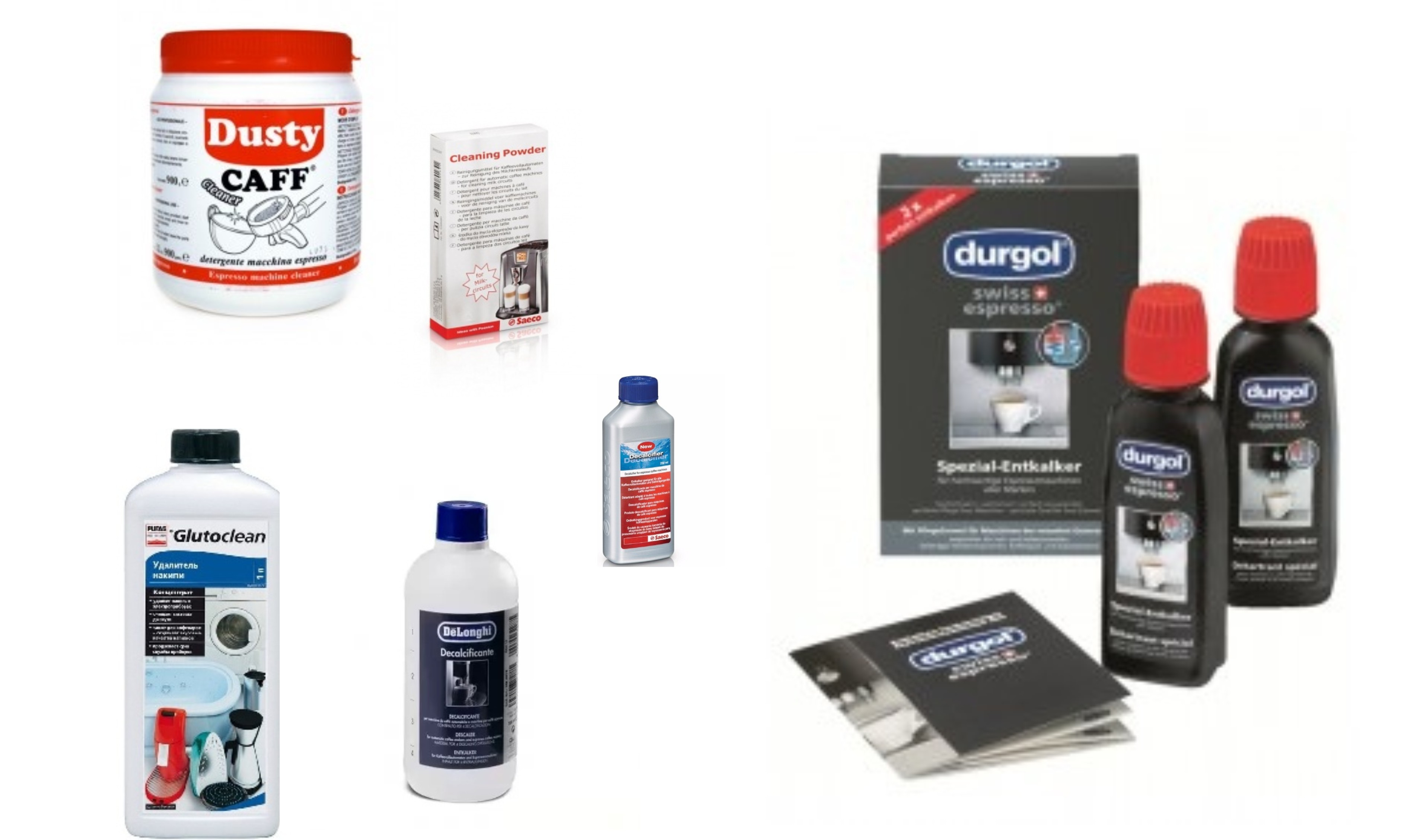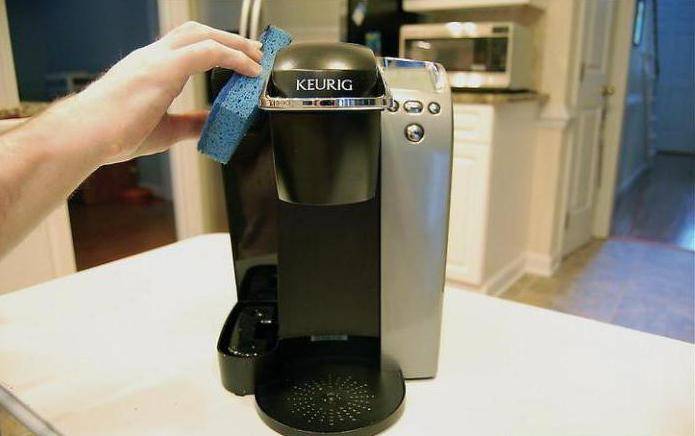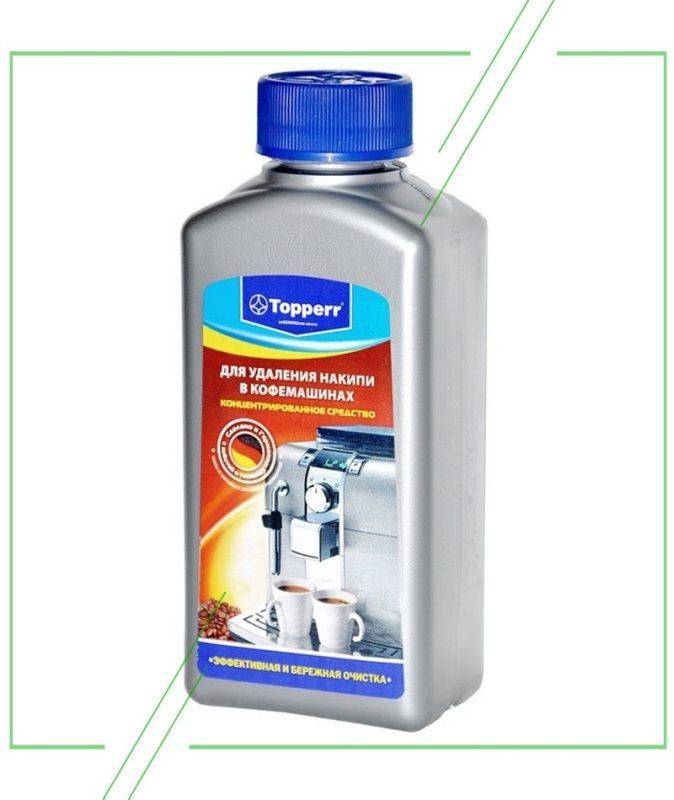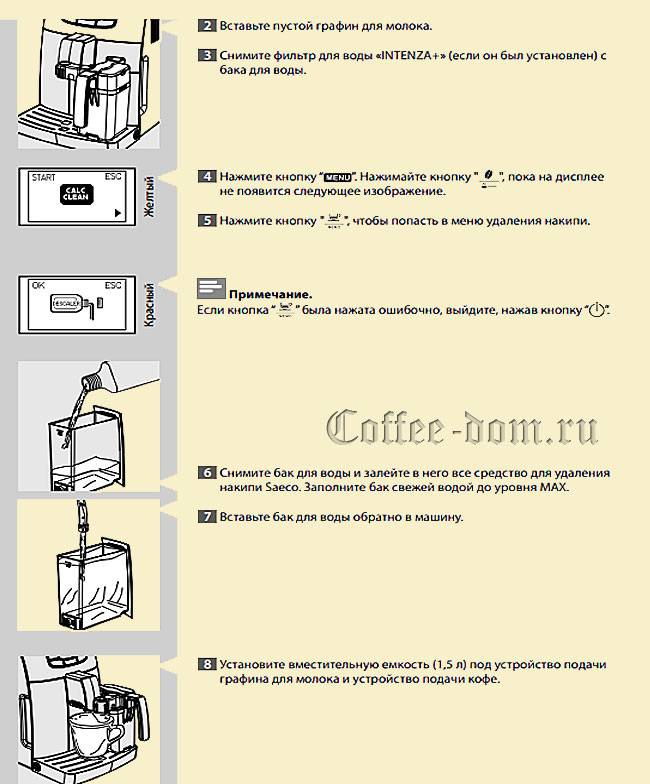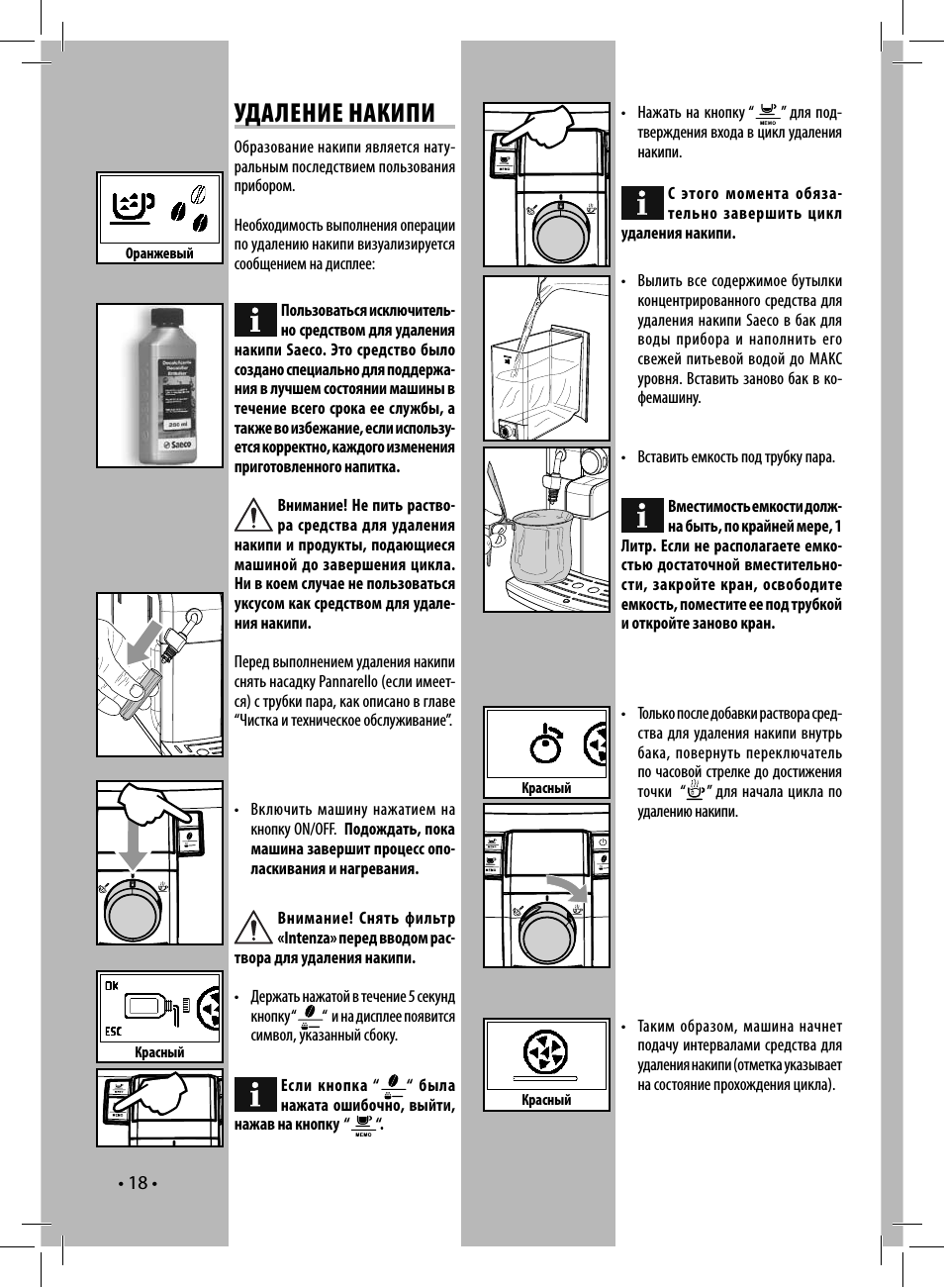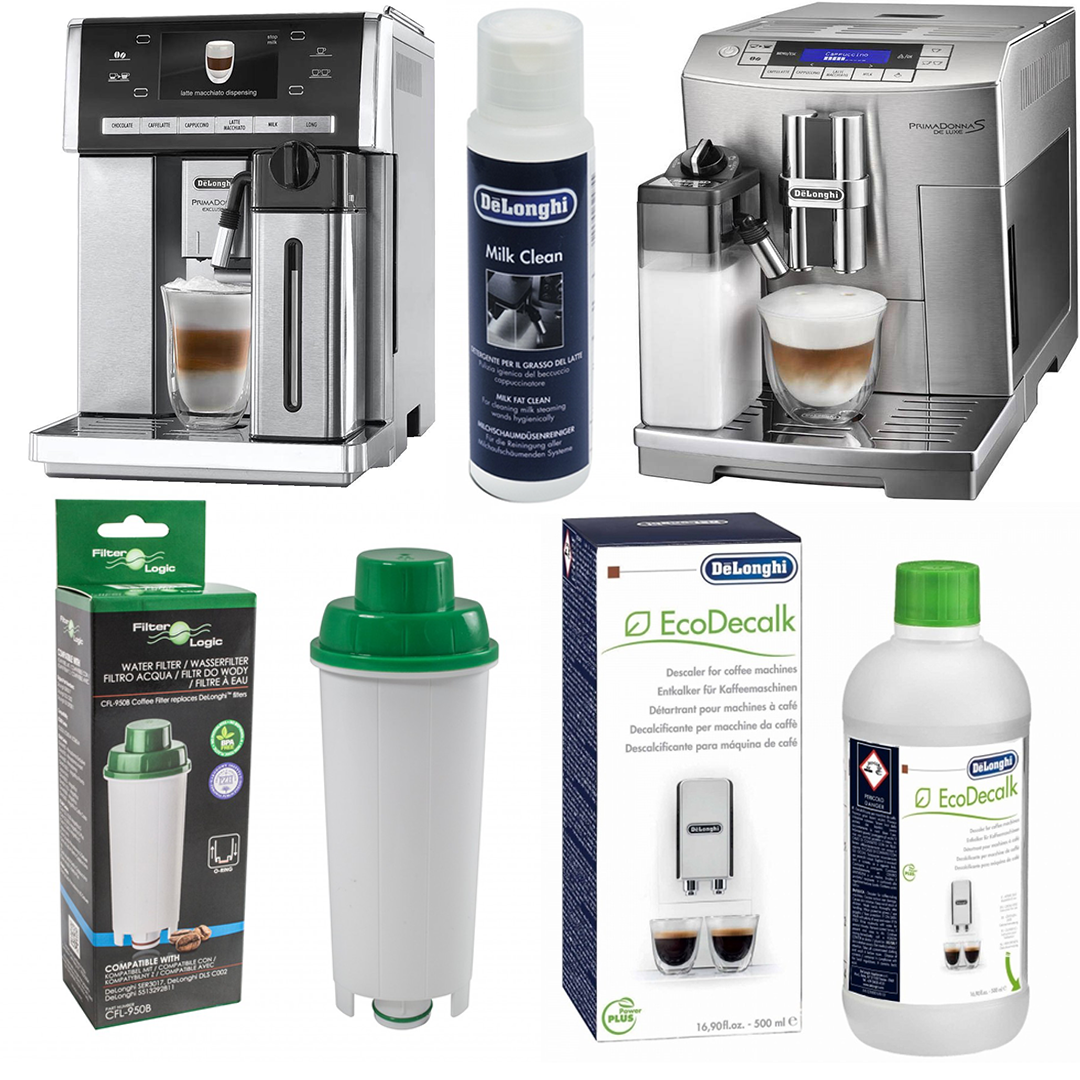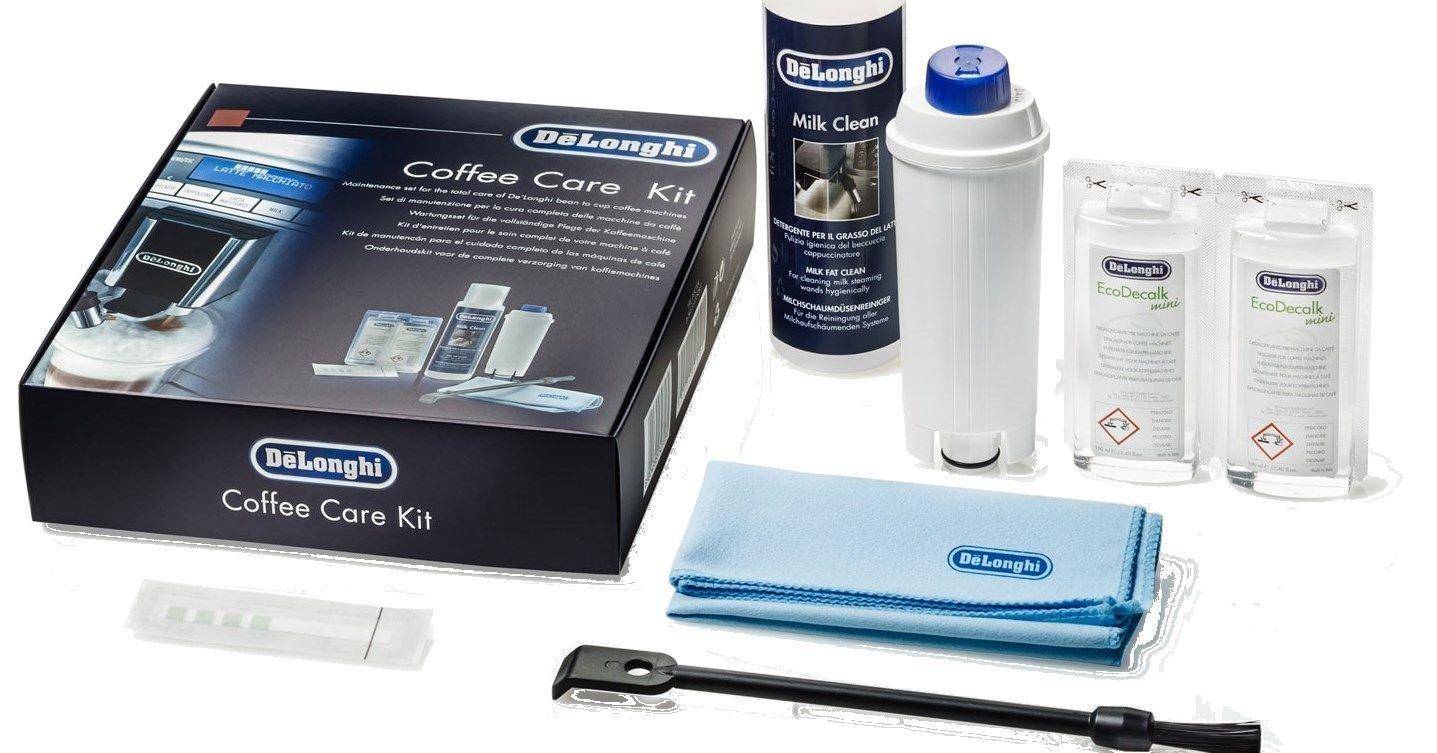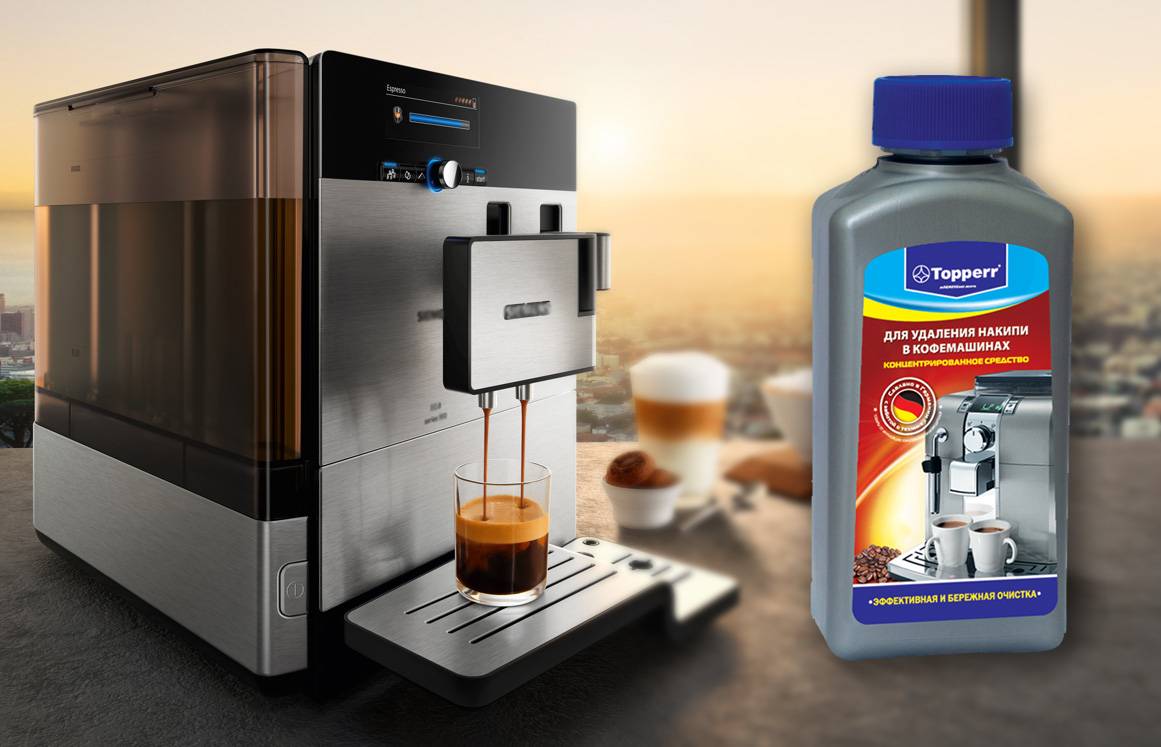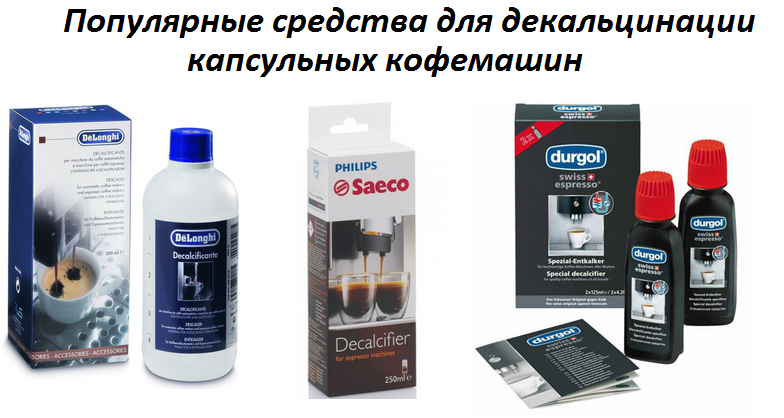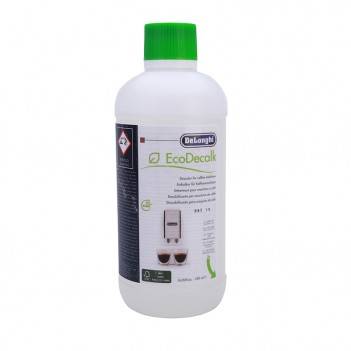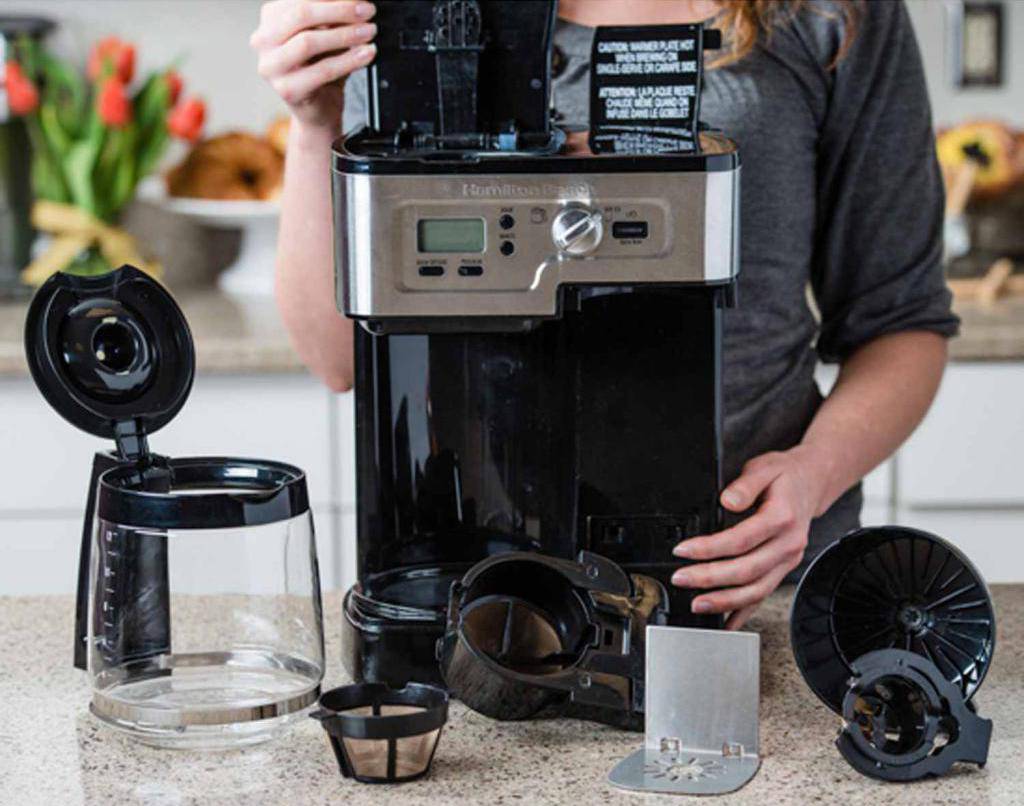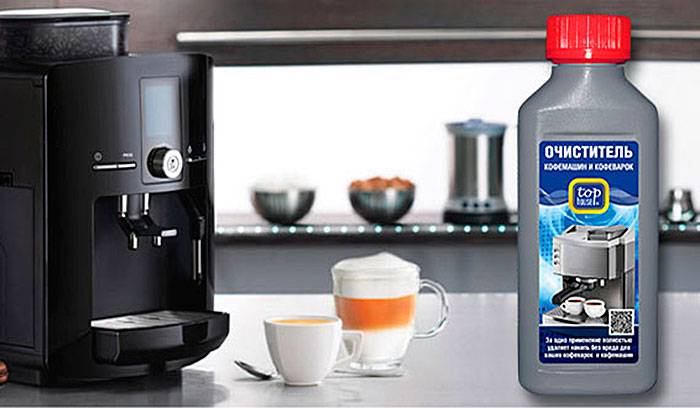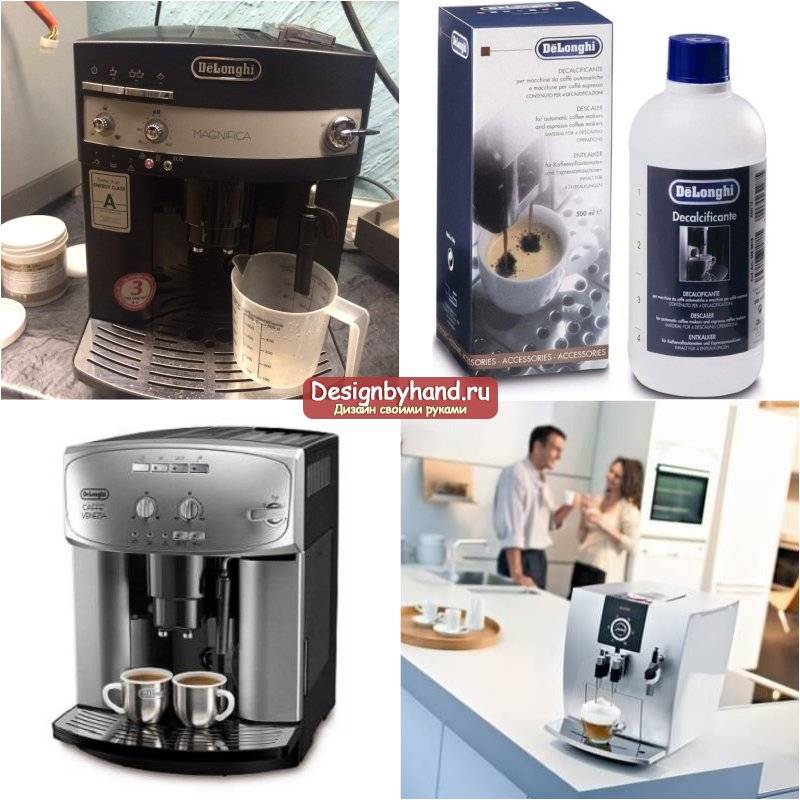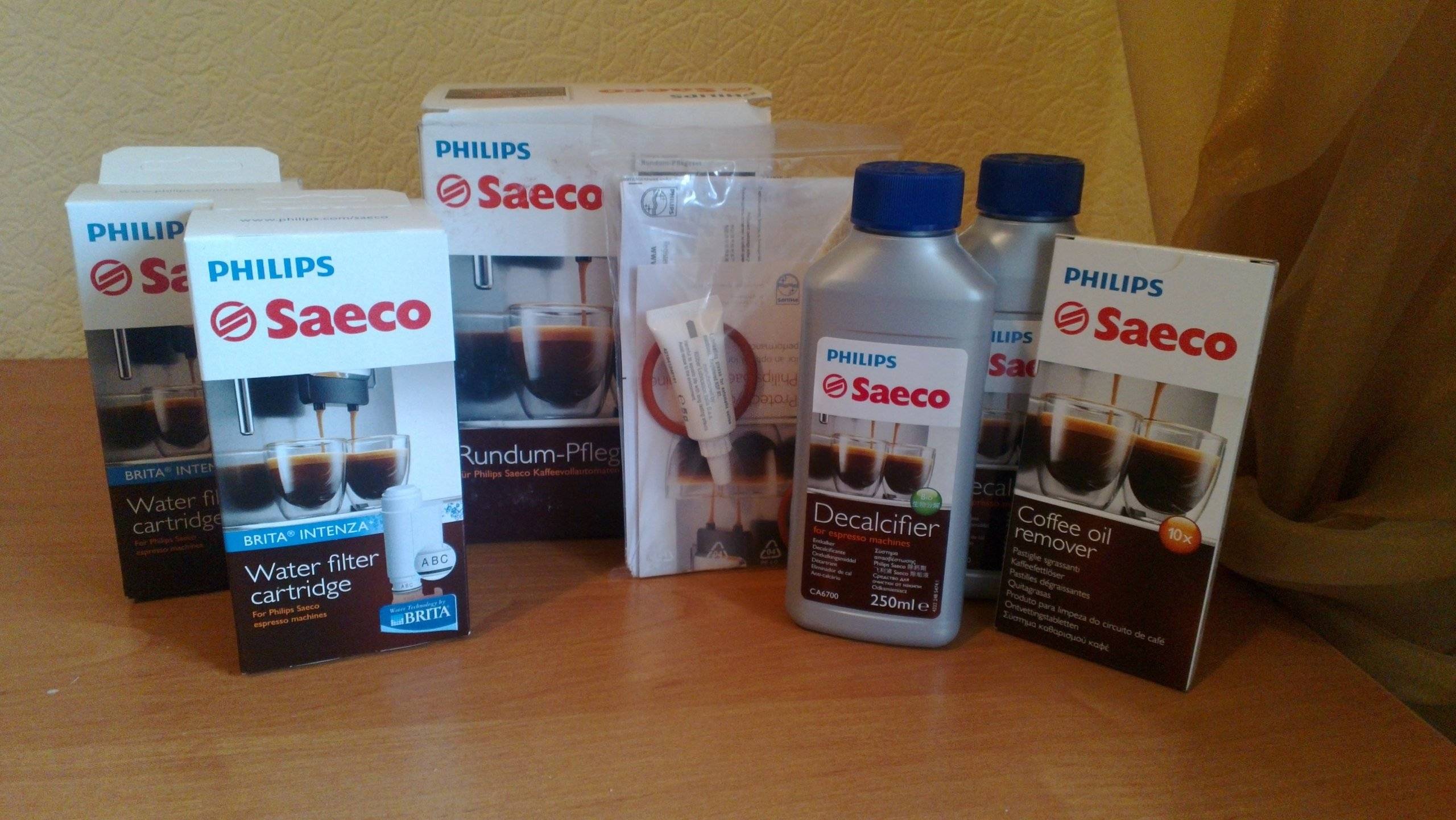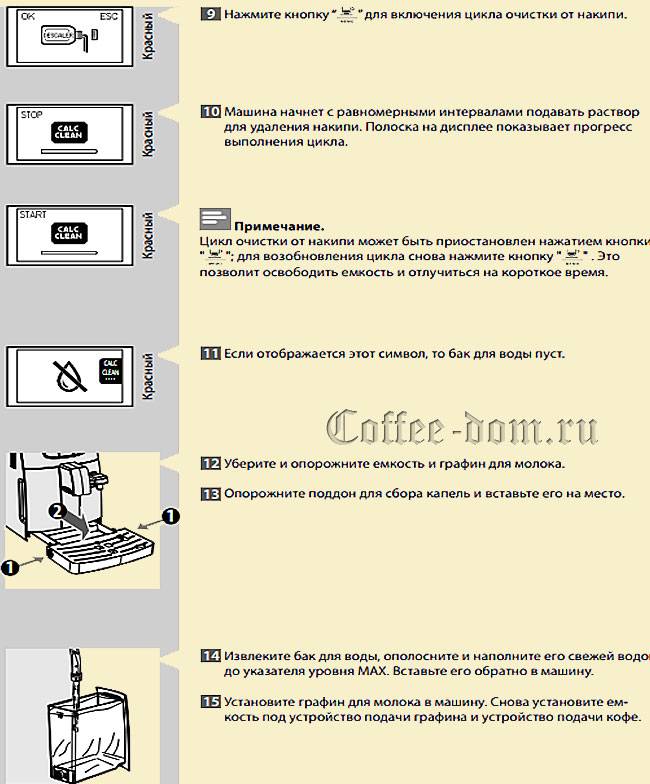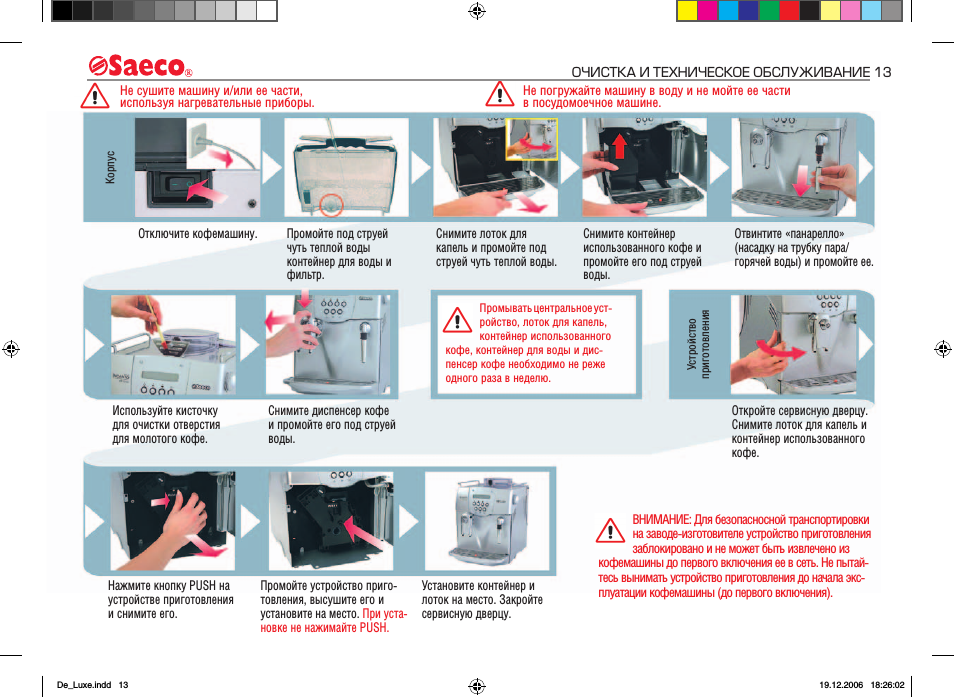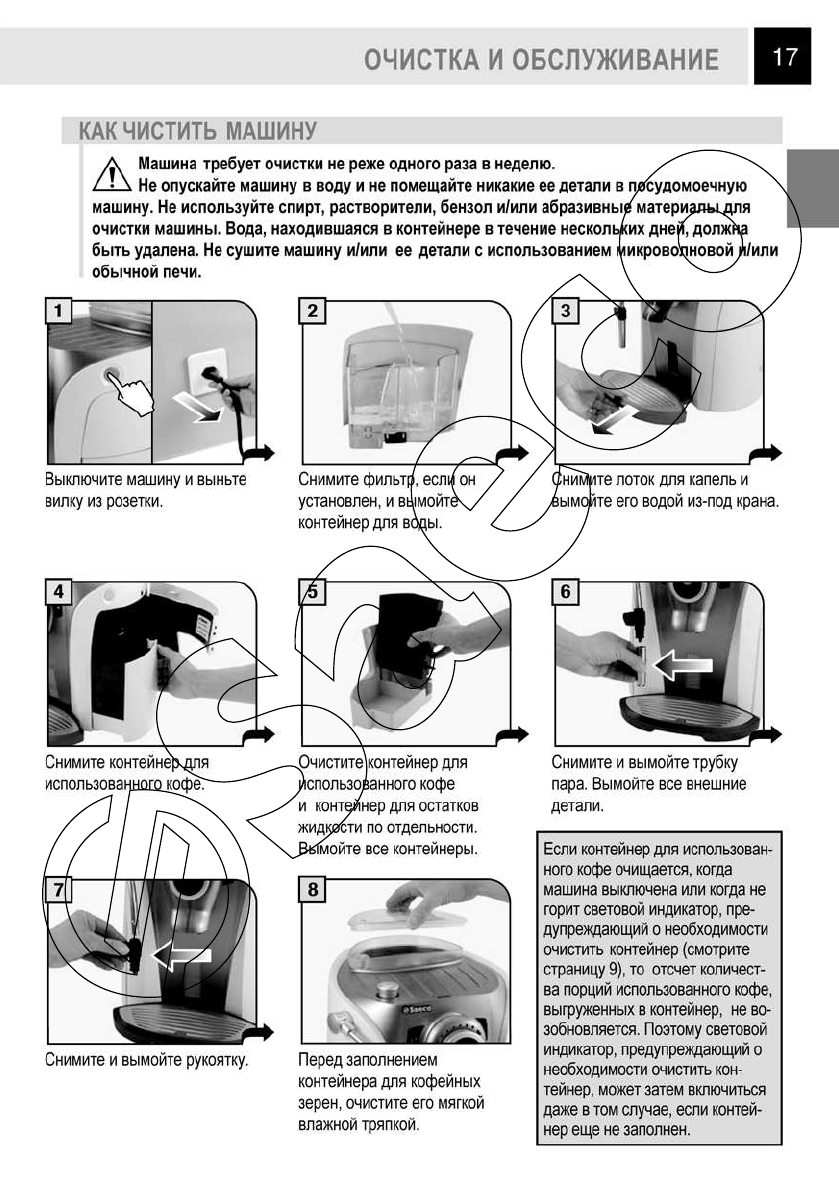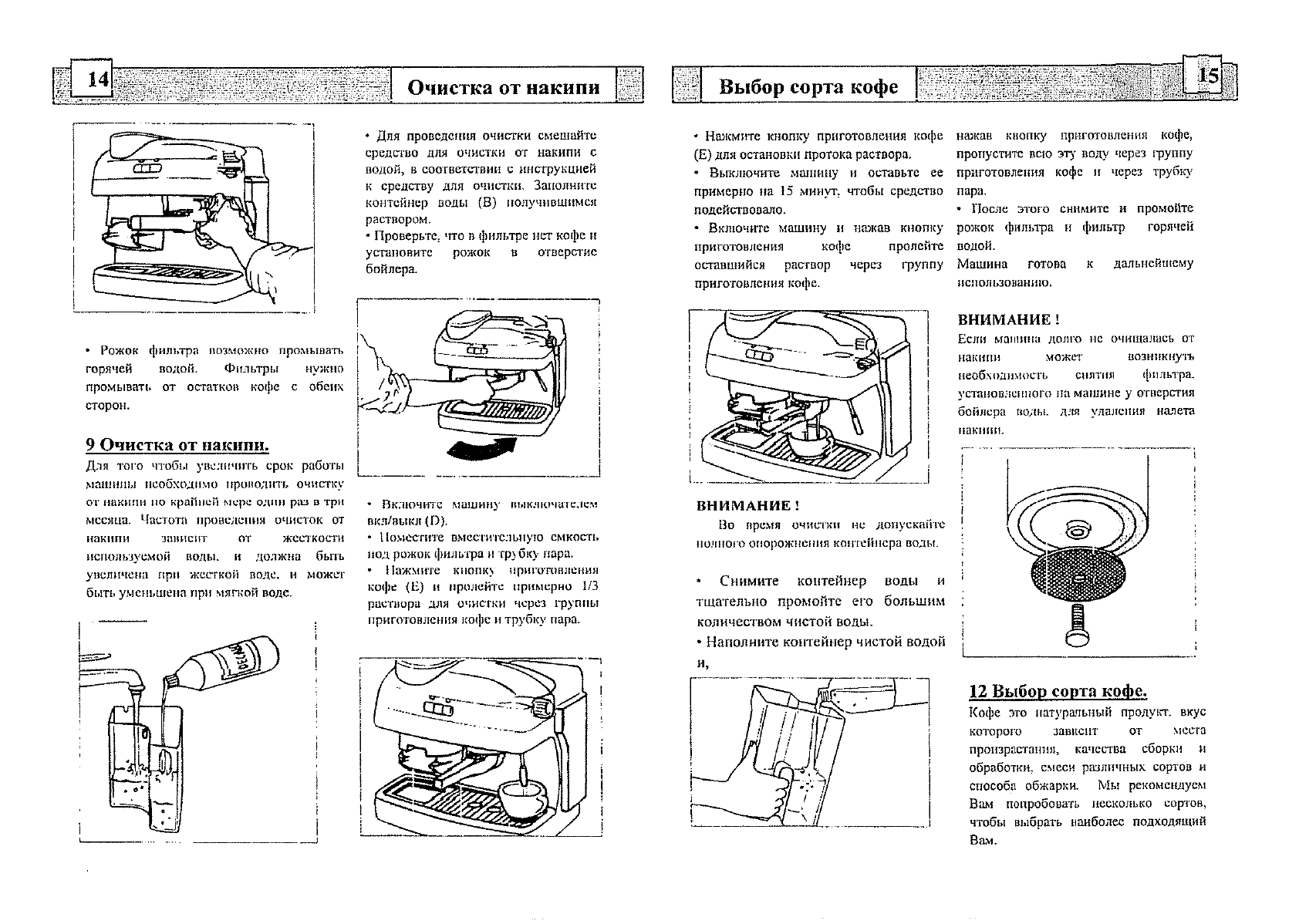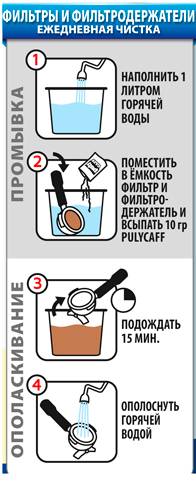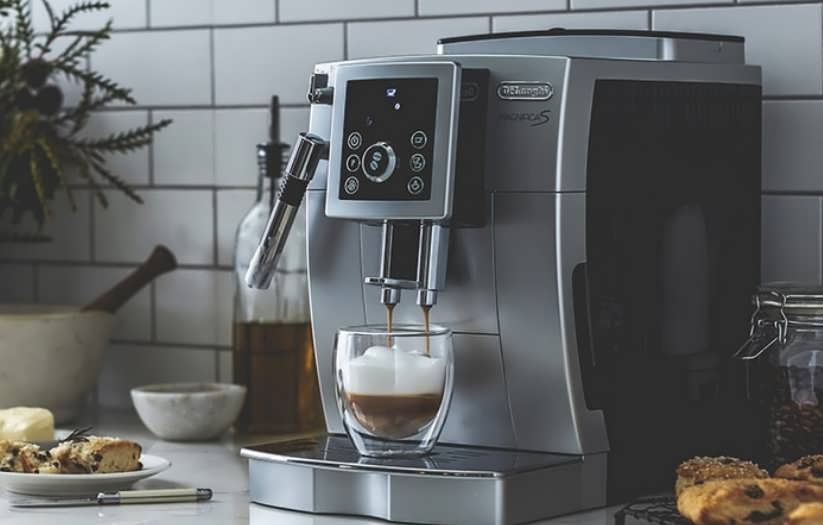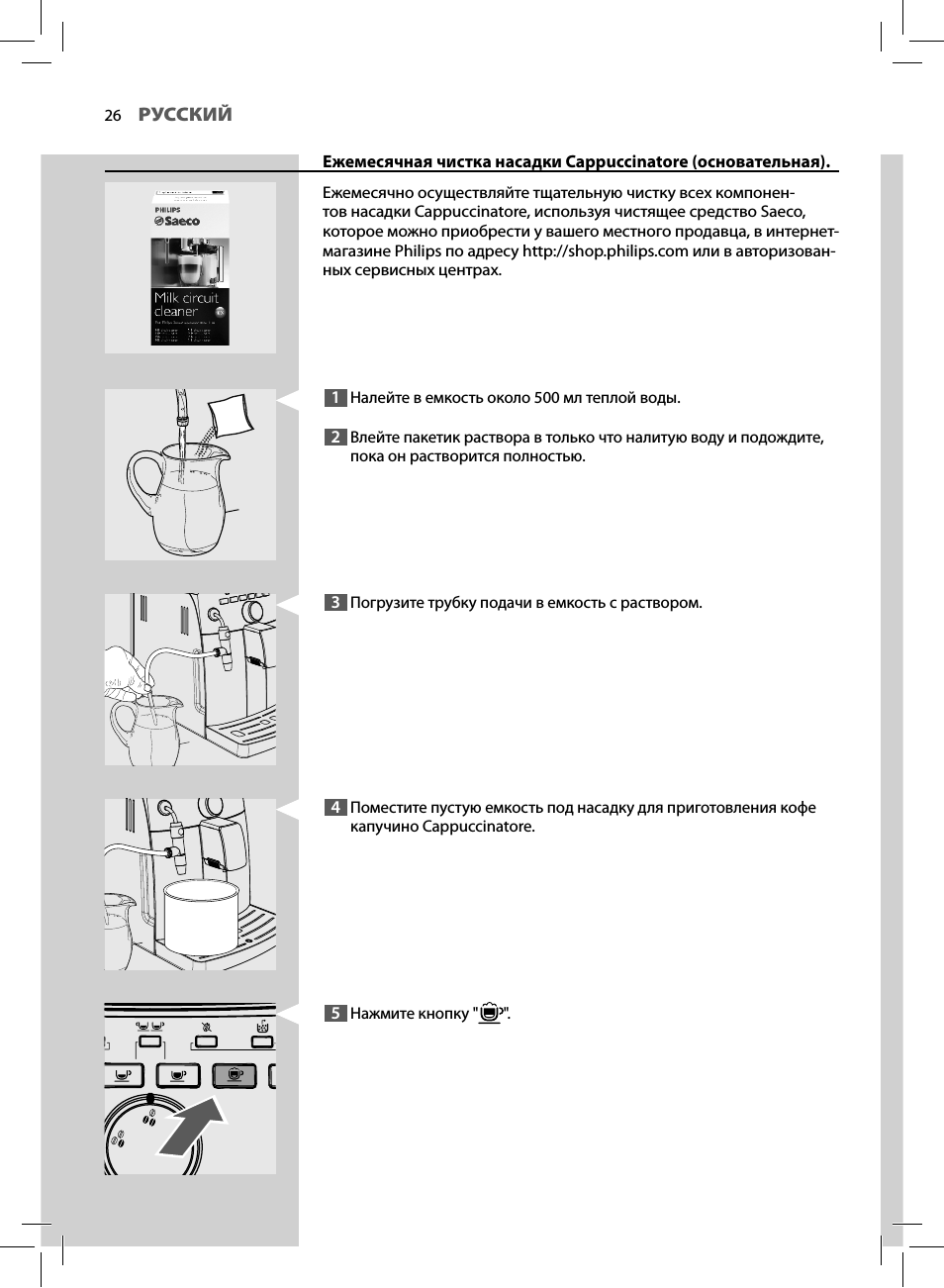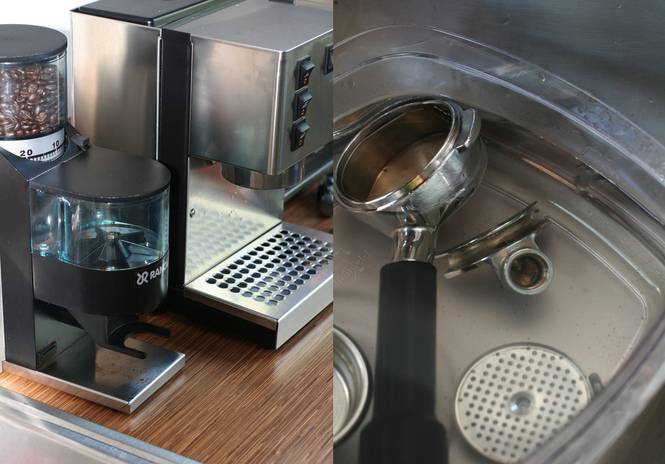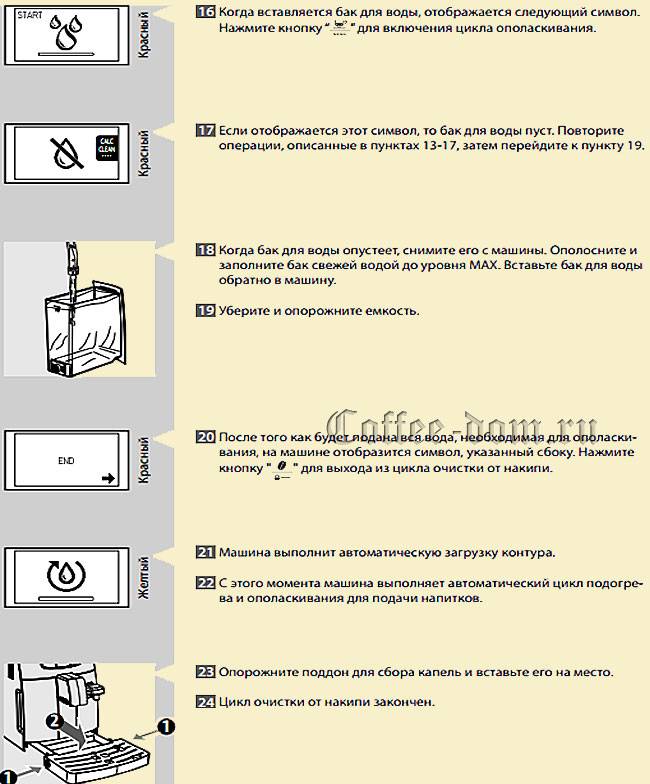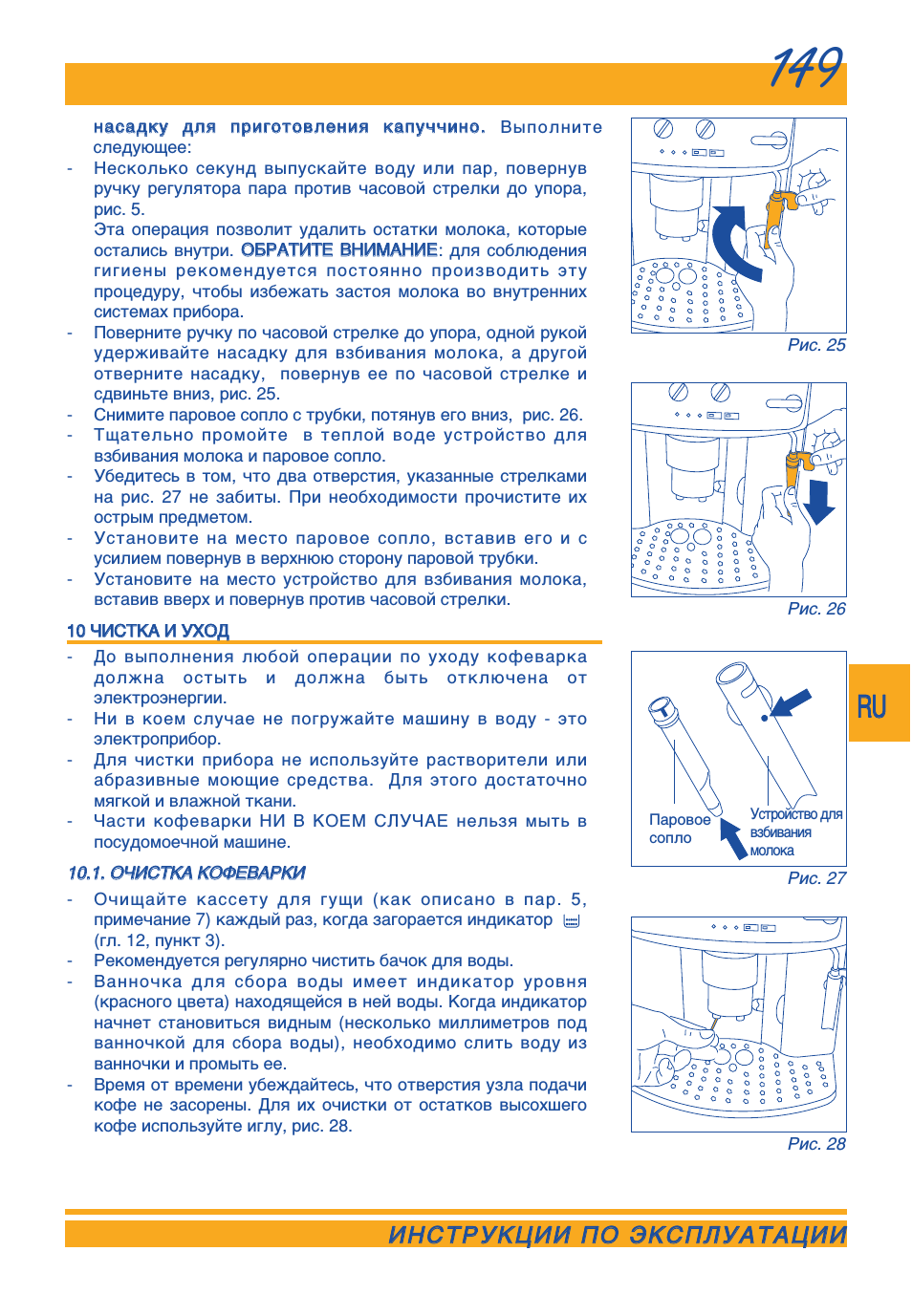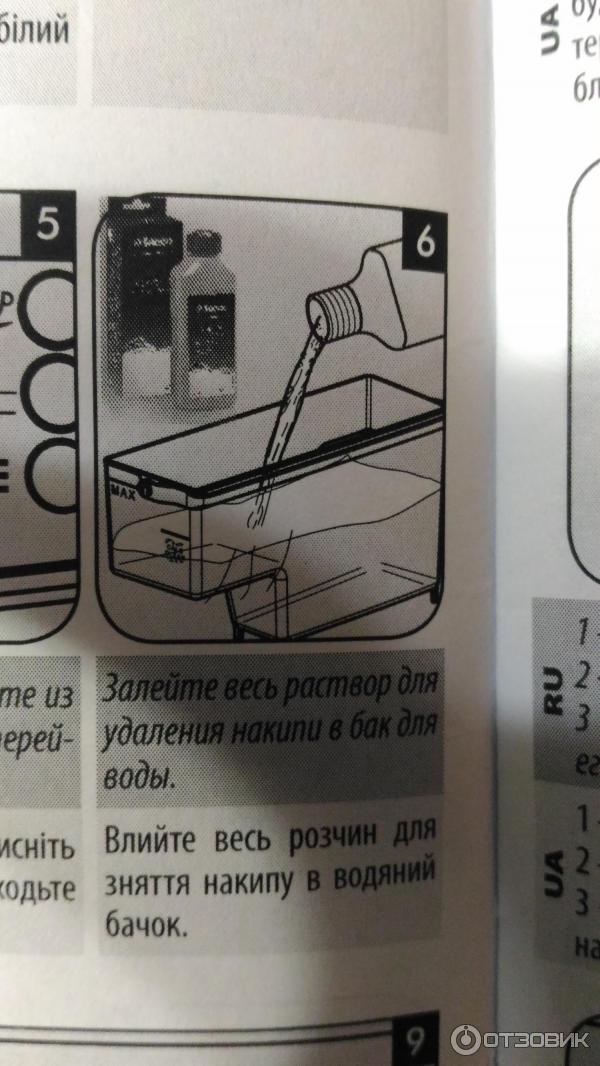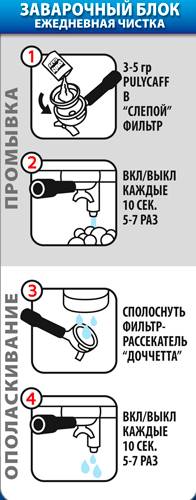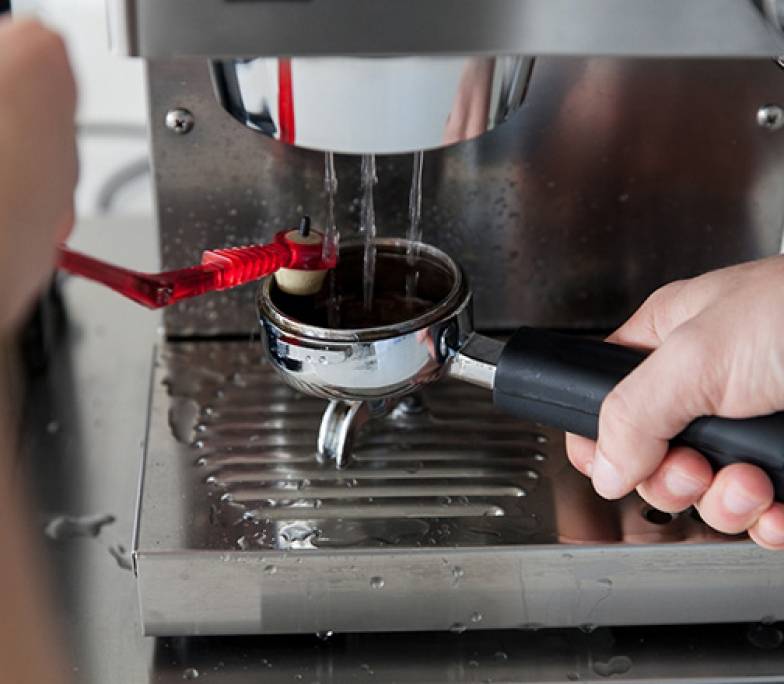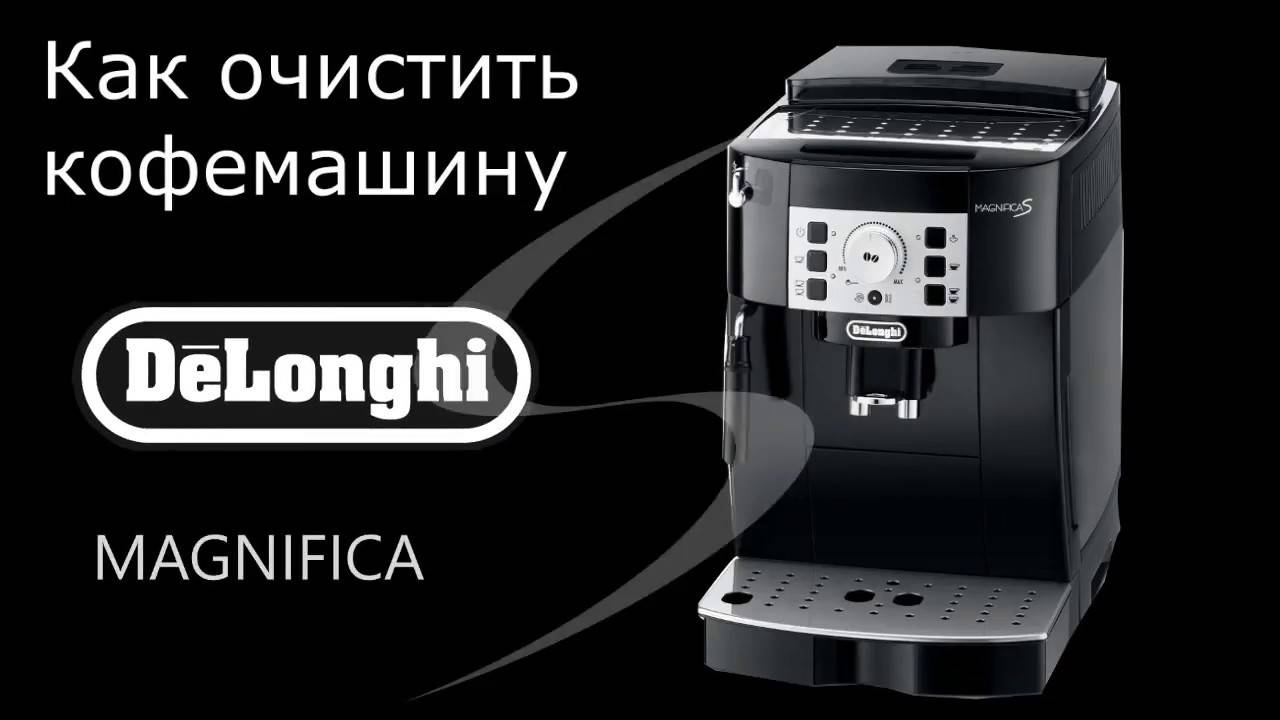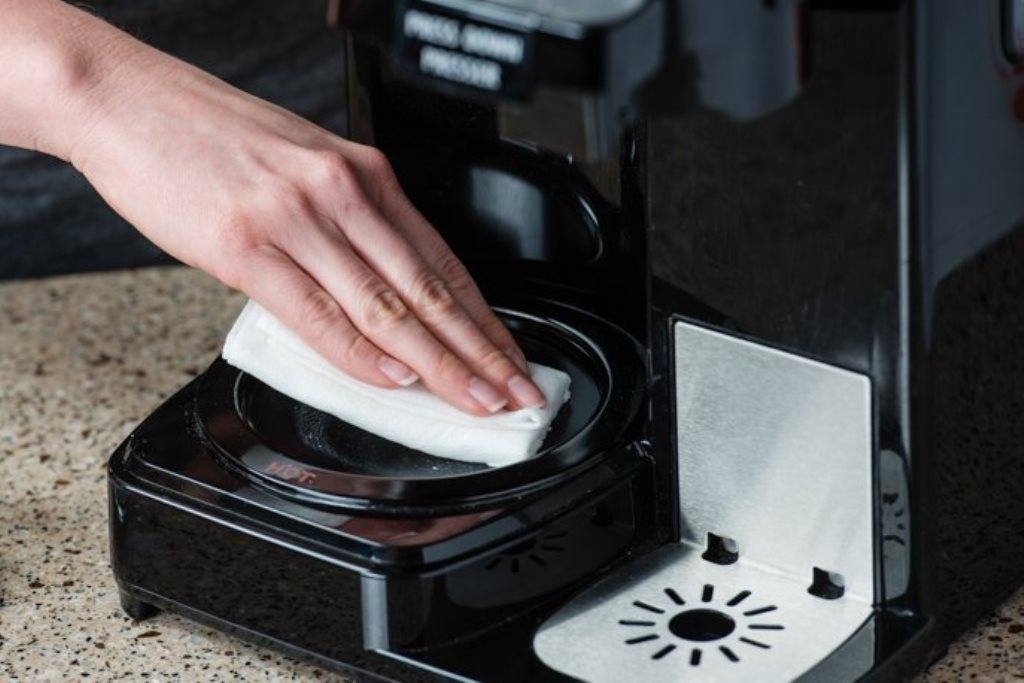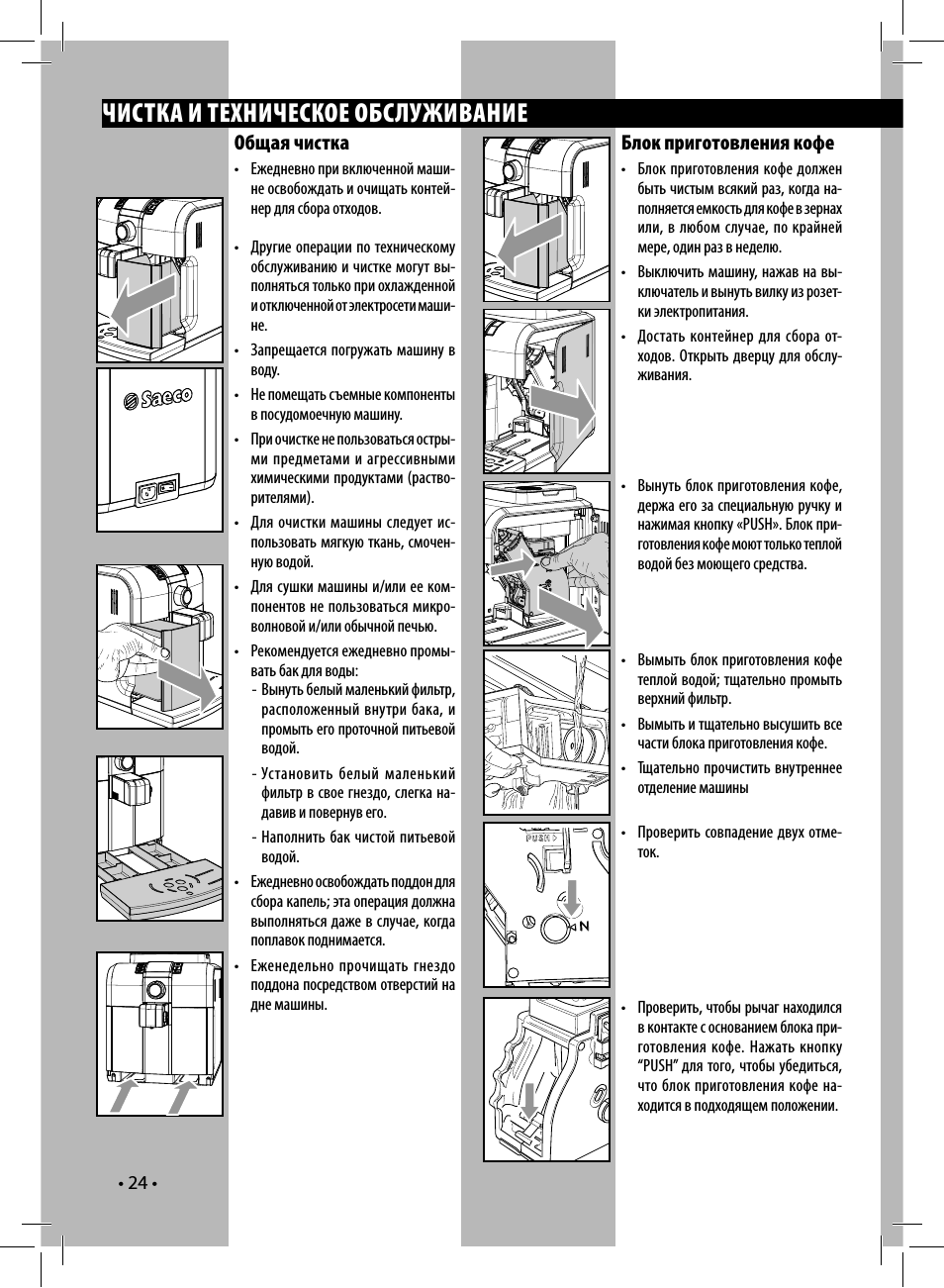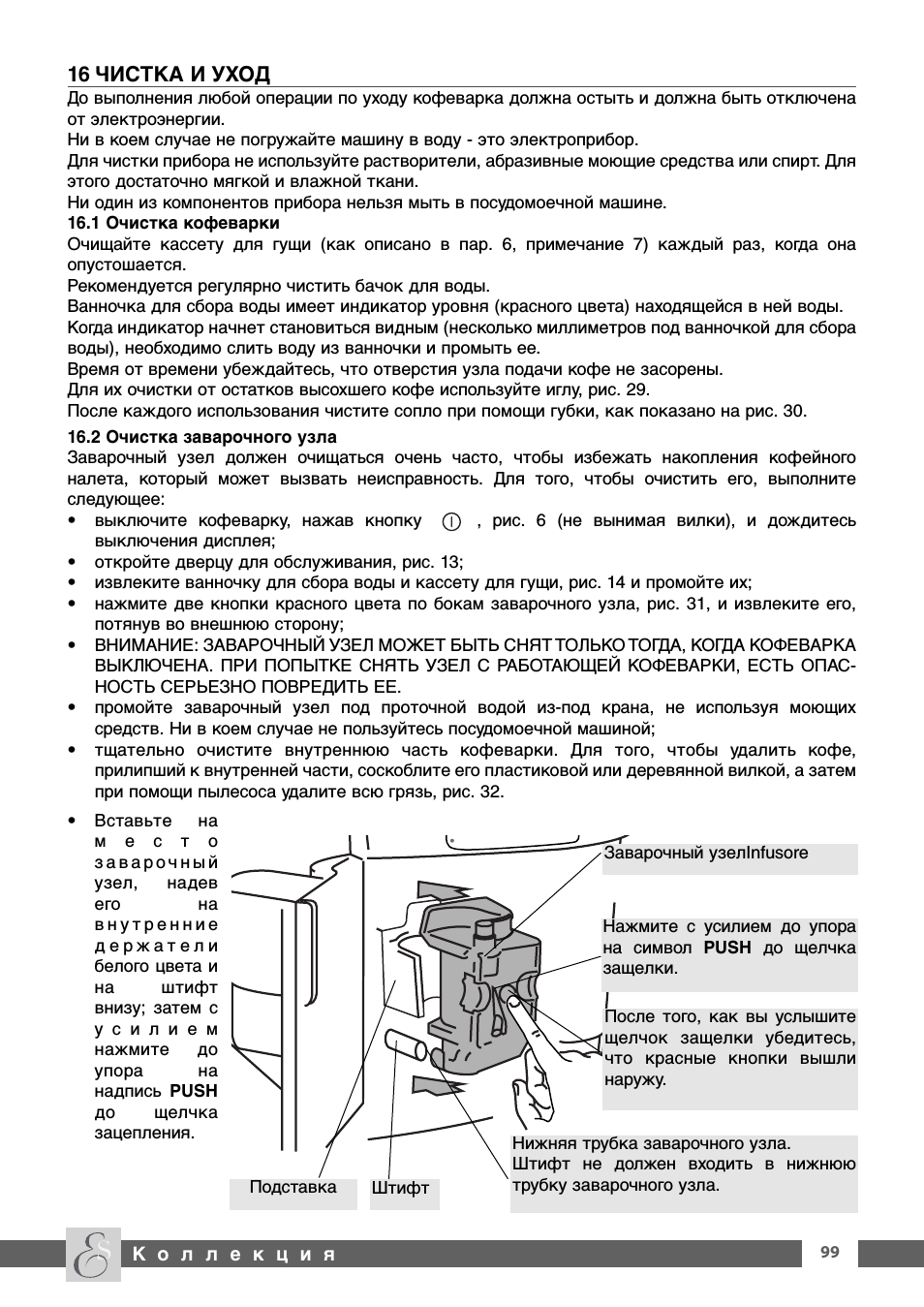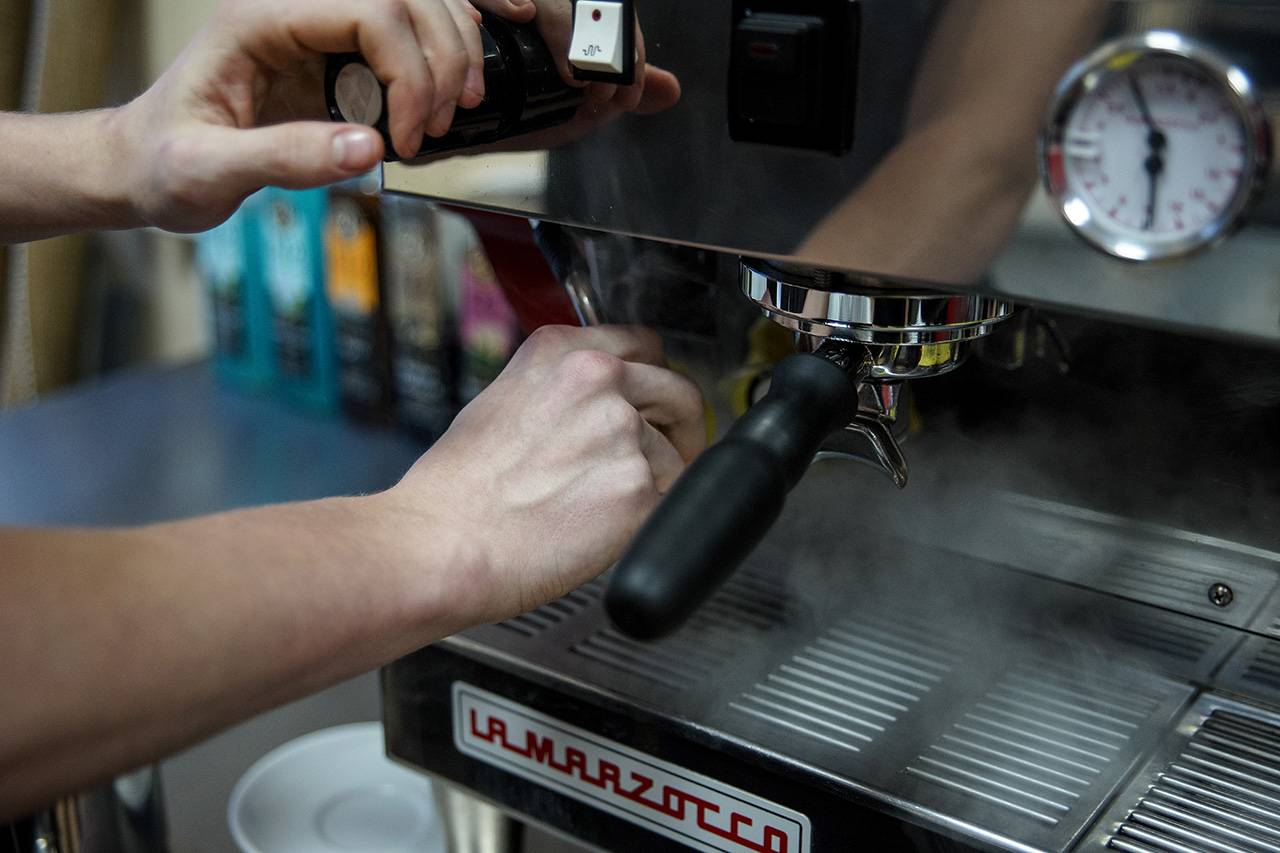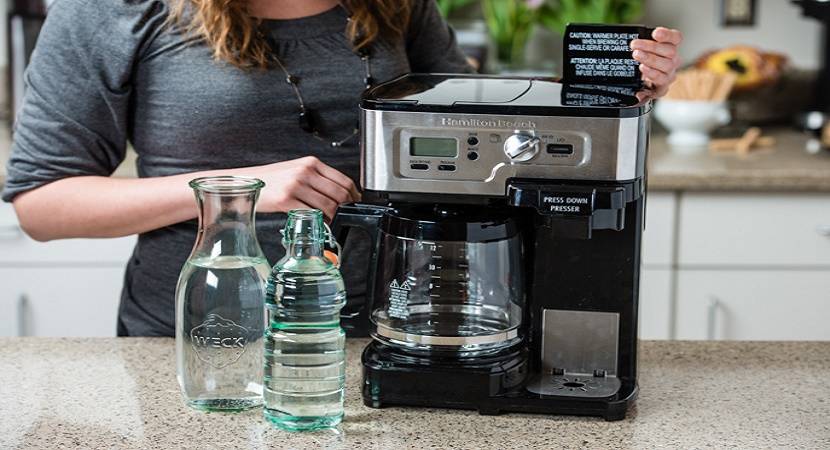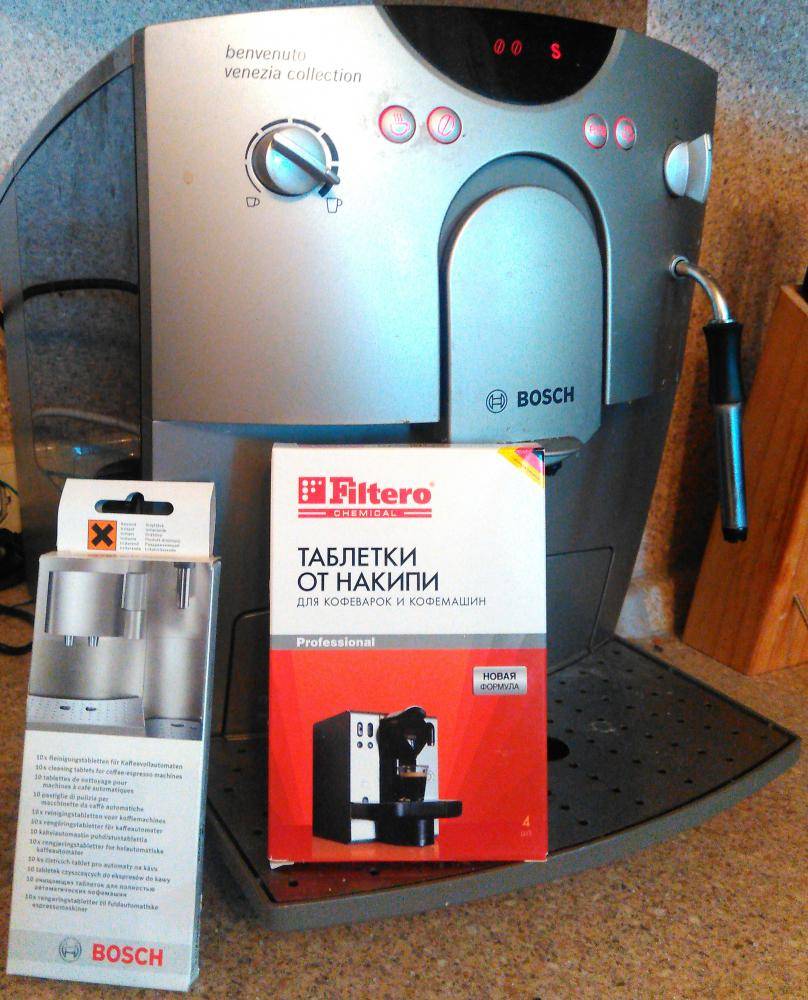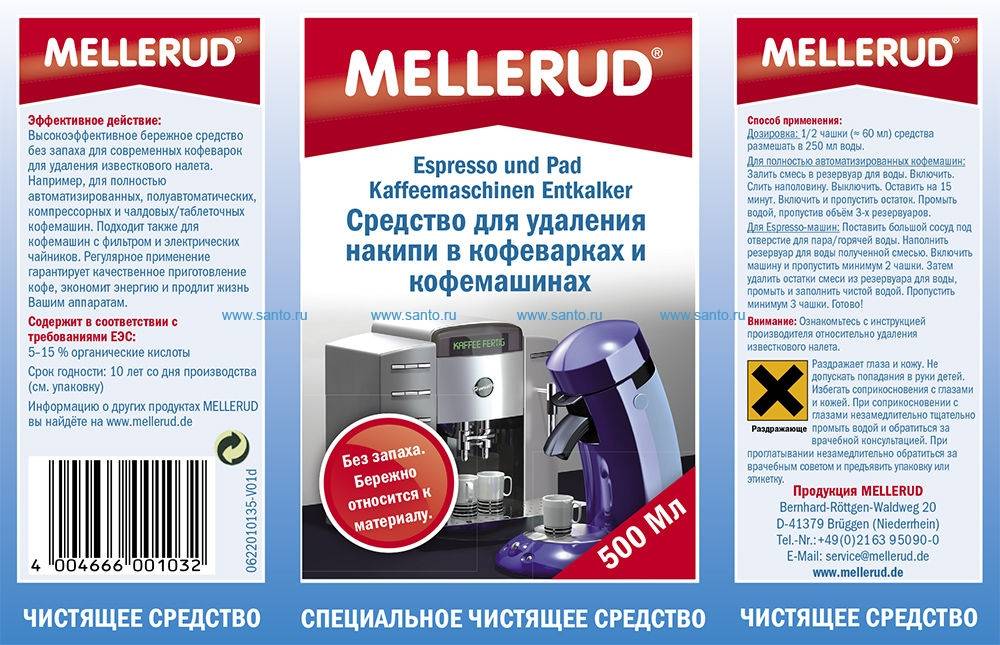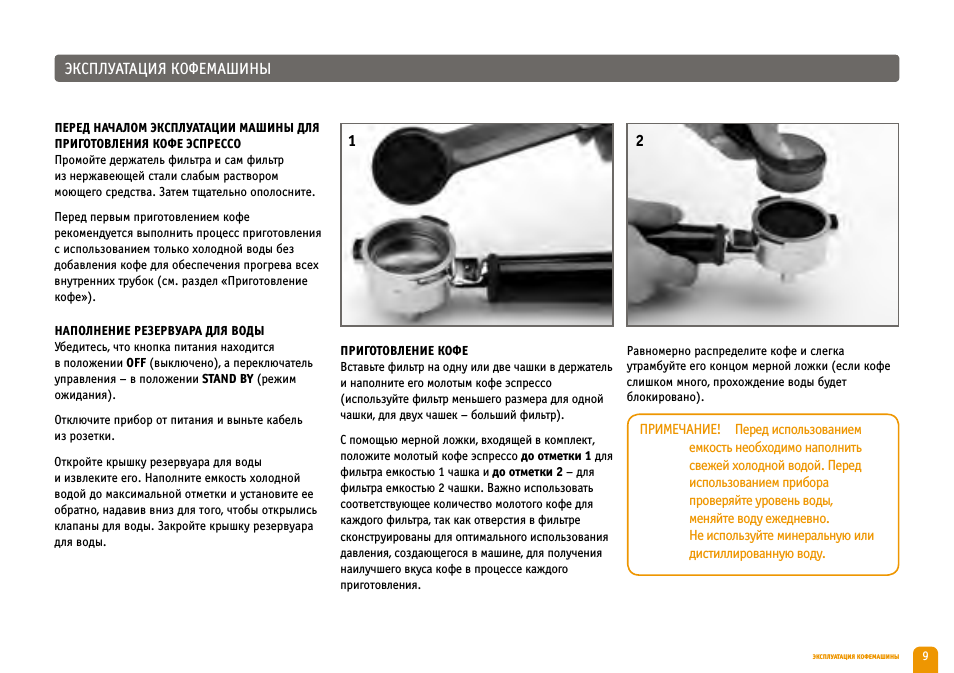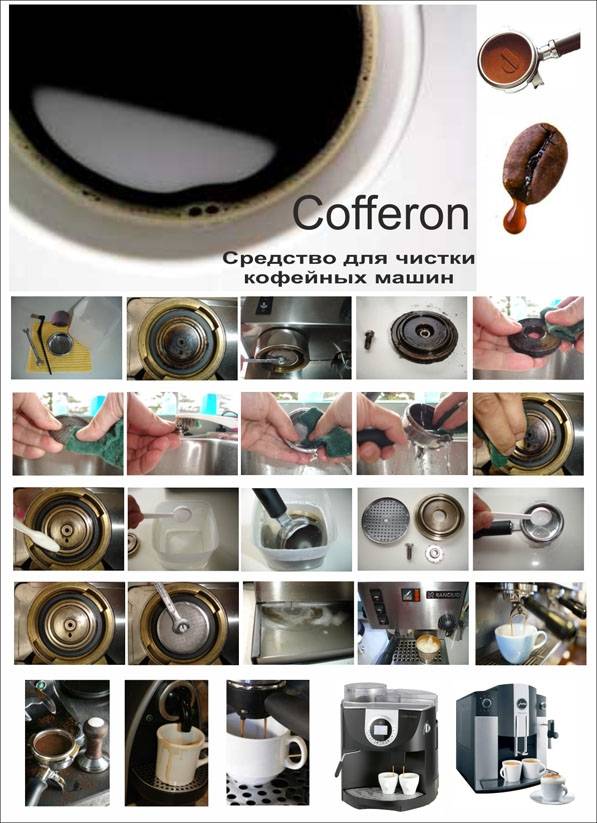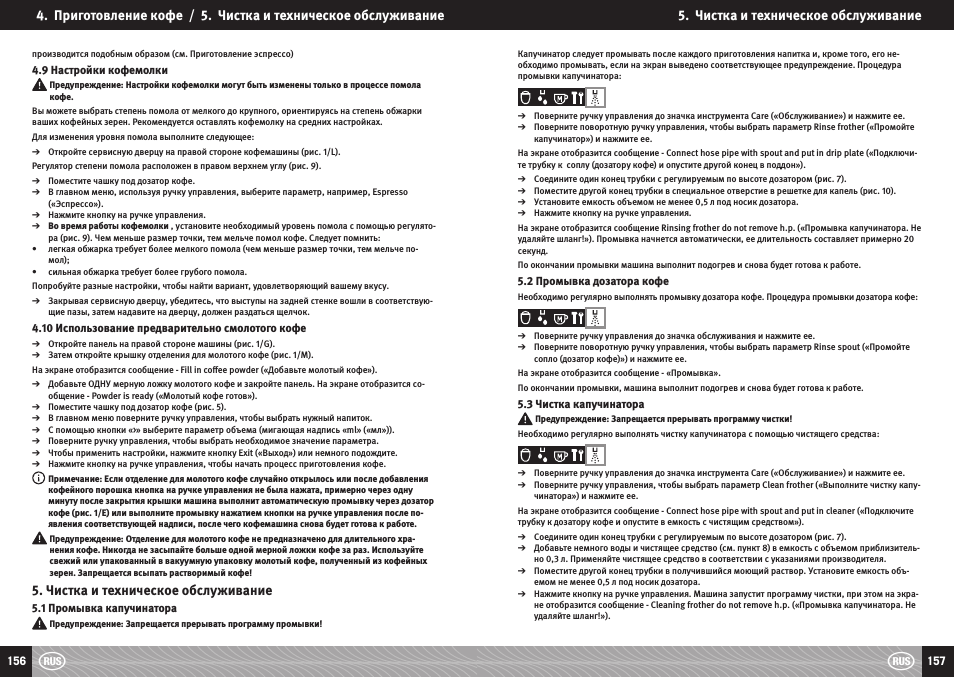How to choose the right product?
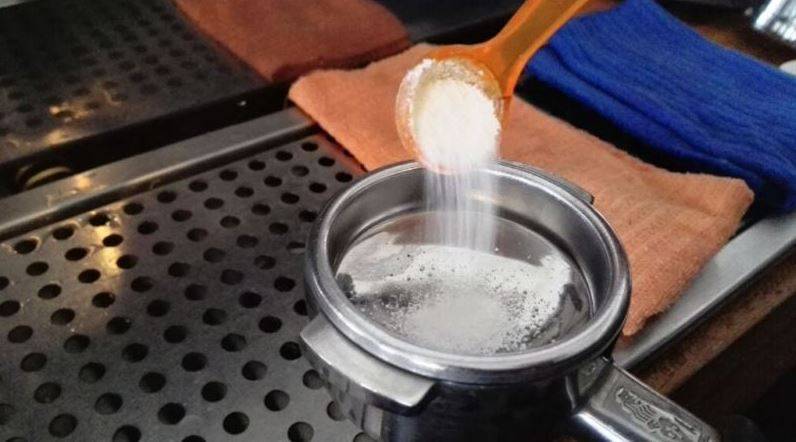
To be as confident as possible in the correctness and efficiency of cleaning the coffee machine, you must follow 3 rules when choosing a product:
- Always use the products recommended by the manufacturer, as for some models the use of uncertified products does not guarantee uninterrupted operation of the device.
- Do not use vinegar and essence, as this can lead to complete or partial destruction of metal parts, which will lead to the complete unusability of the part.
- Be sure to read the instructions for the product and follow all the recommendations.
As for the shape of the cleaning agent, there are no particular differences in them. The tablets are easier to store, but take longer to dissolve. The gel dissolves well and quickly in water, but it is in a bottle for 3-4 applications. The liquid dissolves easily in water, but contains a lower concentration of cleaning agent.
Mechanical cleaning: sequence of actions
Before cleaning the machine, you must remove the waste coffee and the coffee grinder compartment where the beans are located. Clean the holder where the ground coffee and the capsule are placed in the capsule model. Additional containers containing cream, milk, chocolate are also removed.
When the machine is ready, proceed to work:
- Heat the water to 35-40 ℃, dissolve the cleaning agent in it, according to the instructions. If citric acid or soda with salt is taken, keep the ratio of 1 tablespoon to 10 liters of water.
- Put the container with water in place, connect the pipes. In the place of drain, from where it will come out, you need to put a deep container.
- Drain about 100-150 ml through the hot water run button, then turn off the device for 20-30 minutes.
- Turn on the machine and select several different coffee preparation modes (3-4 will be enough). The drained water should be drained.
- Switch off the machine, disconnect the container with water. Rinse it under running water. Pour in plain water that is used to make coffee. Prepare 2-3 cups of coffee without coffee. This will allow the remaining cleaning agent to escape.
- Prepare 2-3 cups of real coffee, but do not use them for food.
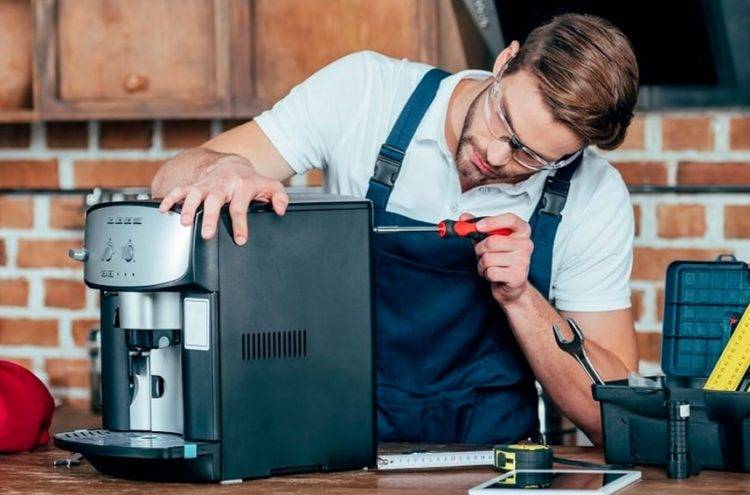 If the coffee after cleaning acquires an unpleasant taste or unusual smell, the cleaning procedure should be repeated, increasing the volume of water for the final stage.
If the coffee after cleaning acquires an unpleasant taste or unusual smell, the cleaning procedure should be repeated, increasing the volume of water for the final stage.
Some models of coffee machines have an auto-cleaning function. To do this, pour the detergent into the indicated container and press the corresponding button. All the nuances of this work are described in the instructions. But, not every model can boast a set of such additional functions. This does not mean that cleaning is unnecessary.
Before carrying out this kind of manipulation, it is important to read the instructions. There are nuances characteristic of a particular model, non-observance is fraught with the appearance of breakdowns.
Types of pollution
The devices may contain the following contaminants:
- Scale. Each coffee machine has a ten, which, when used, becomes covered with limescale. Typically, this is the reason equipment deteriorates. Deposits lead to cementing of the water channels, which complicates the circulation of water, and the parts become brittle. Various chemicals are used to remove deposits.
- Coffee oils. The finished coffee is fed through the system to the mug. Over time, coffee oils settle in the hydraulic system and impair the taste of the beverage. To remove them, perform a system cleaning.
- Milk residues. If it is possible to prepare cappuccino in the appliance, then after each cup the system must be cleaned with a grease remover.
Diagnosing the problem
The user can face many problems when the coffee machine:
- Doesn't brew coffee.
- Does not form a tablet.
- Does not collect water (or does not heat it).
- Does not froth milk.
- Does not grind grains.
- Capsule problem.
- Noises, hums, etc.
 The most common cause of reduced appliance life is scale formation.
The most common cause of reduced appliance life is scale formation.
To eliminate the malfunction, it is necessary to understand the possible causes of the breakdown. Among the main ones are:
- The seal is damaged.
- The filter is clogged.
- The heating element is broken.
- Air valves clogged.
- The pressure control system is out of order.
- Electric motor burned out.
- The grinder is broken.
- Clogged hydraulic system.
It is always easier to prevent a problem than to solve it later.
It is important to remember that a change in the taste of the drink is the first sign of the presence of scale, particles of which get into the drink and form a sediment at the bottom of the cup. There are no limescale sensors in the heating system of the coffee machine, the machine only counts the number of liters of water used
Accumulation of limescale and coffee oils on parts is the most common cause of machine failure. If parts are worn out or the internal structure is broken, it is likely that you will not be able to solve the problem on your own, but timely cleaning of the coffee maker will help to avoid the formation of rust.
 Proper handling of the coffee machine will save you from premature breakdowns and costly repairs.
Proper handling of the coffee machine will save you from premature breakdowns and costly repairs.
During coffee preparation, steam is forced through the ground coffee under pressure. As a result, coffee (or essential) oils and hard salts accumulate in the places of evaporation, forming scale and making the operation of the coffee machine difficult.
 The manufacturer describes in detail the conditions of use and maintenance of the device.
The manufacturer describes in detail the conditions of use and maintenance of the device.
Folk remedies
Citric acid cleaning
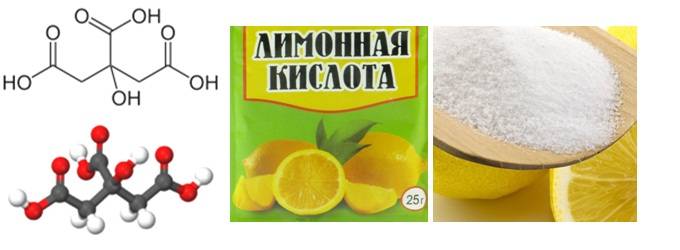
This option is suitable for cleaning fresh limescale. That is, one that has not yet formed a thick layer and has not become tough. Cleansing can be carried out on any teapot. Plastic, metal and glass are suitable. It is necessary to dissolve 2 tablespoons. citric acid (fresh lemon is suitable) in 500 ml of water. As a result, a not very aggressive solution will come out.
Execution order:
- Pour liquid into the device and boil it.
- Pour out the acid or just take one lemon and squeeze all the juice inside.
- Wait two hours until the liquid cools down.
- Shake to dissolve the scale build-up.
- Pour the prepared mixture
Soda cleaning

Soda contains phosphoric acid. It perfectly loosens salt deposits on the walls of the kettle. It is better to use colorless drinks, such as Sprite or Schweppes, so as not to paint the inside of the dishes. Before starting to use, it is necessary to remove the gas from the drink. This will prevent foam from accumulating.
To do this, shake the bottle well, and then gently open it, wait a couple of minutes until the abundant release of bubbles ends. After that, the soda must be poured into the device, boiled, then wait until it is completely cooled. After that we rinse the kettle.
Brine cleaning
The brine is poured into a kettle, boiled for 25-30 minutes. Then the contents are shaken and allowed to cool completely. This method removes rust and scale well.
Operating rules
During the operation of the machine for making coffee, it is important that all the rules of use described in the instructions are followed, as well as the timely cleaning of the coffee machine according to certain rules. Every time you brew coffee, you need to do this cleaning regularly.
The built-in mechanism will help with this. This should be done in this way:
Every time you brew coffee, you need to do this cleaning regularly. The built-in mechanism will help with this. This should be done in this way:
- We turn on the device;
- After full heating occurs, select "RINSE" in the menu, the rinsing phase will start;
- When cleaning is complete, you can start making coffee.
Types of specialized decalcification products
Basically, each manufacturer of automatic coffee machines produces special products for removing calcium deposits only for their own models. However, you should not always adhere to this rule. Other products that come in powder, tablet, or liquid form are also suitable. The main thing in this matter is quality.
Liquid products
The most demanded funds are:
- Saeco;
- Delonghi;
- Magnifica;
- Jura.

Selection of liquid products for decalcifying the coffee machine.
Delonghi cleaner is more often used for Delonghi brand appliances. They guarantee a good result. Saeco Thinner is inferior in price, but not in quality. The most budgetary option Magnifica. The product has a less expanded composition of elements that reacts with salts. However, constant use gives good results.
In pill form
The solvents listed above are also available in the form of special tablets. Their active elements work in such a way as to act directly on the desired part subject to calcium build-up.
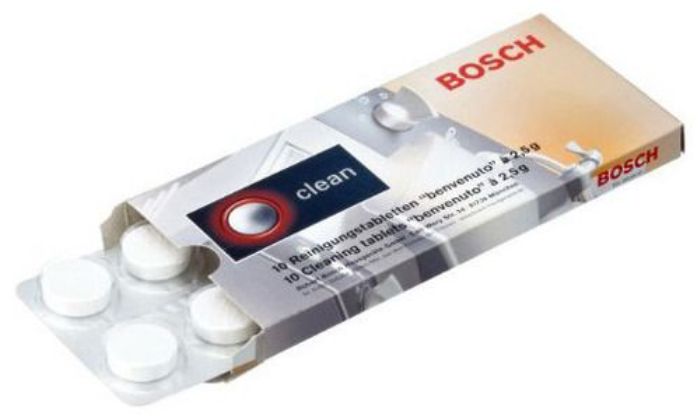
Means in the form of tablets for cleaning coffee machines.
The right tablet formulation is ideal for descaling. You can also find universal tablets on sale.
How is manual cleansing done?
Before an independent cleaning procedure, you should first study the instructions for the device. Basically, the manual cleaning method is universal for all models:
- rinse the filter and container from coffee residues;
- pour liquid solvent into the water container up to the maximum mark;
- turn on the coffee machine and open the tap;
- drain the liquid about 150 ml;
- pour off the product in small portions at intervals of 5 minutes.
If the appliance does not have a pulver, before the cleaning solution runs out, add coffee and start the coffee preparation program. Pour the resulting drink. A carob or pulverized machine does not require the addition of coffee.
When all the liquid is drained, rinse the reservoir well and fill with cold clean water. Repeat the procedure.
Use of pills
Dissolve the tablet completely in clean water before use. Fill the reservoir with liquid and turn on the drink preparation mode. As soon as half of the glass is full, turn off the program. Start the car again after 15 minutes. The rest of the liquid will drain into the glass. Rinse the brewing unit and start cooking twice, but without coffee and tablets.
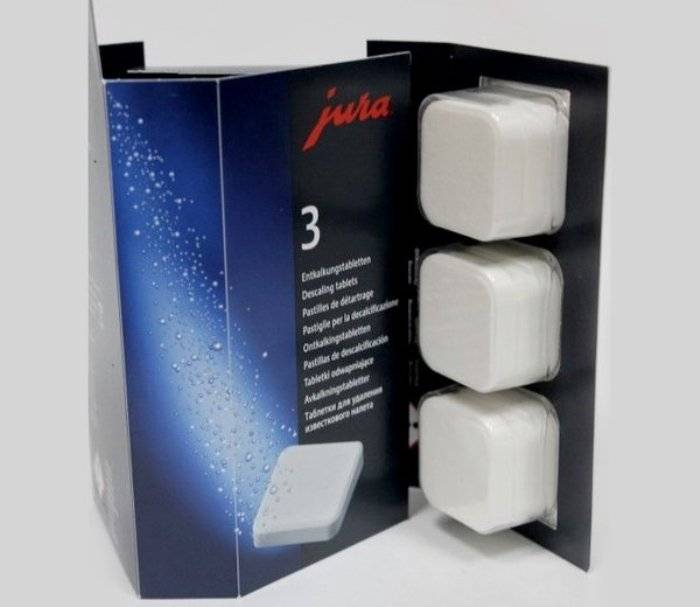
Before using the tablets, you need to dissolve them in water.
Features of automatic cleaning
What is the automatic decalcification procedure in a modern coffee machine? This is a self-descaling function, which greatly simplifies the cleaning process.
Let's consider how to carry out the decalcification process using the example of a Delonghi model coffee machine:
- remove coffee from the machine;
- fill the liquid compartment with the prepared agent;
- activate the self-cleaning program;
- wait a while for the procedure to be completed, which the coffee machine will carry out on its own.
How to properly descale a coffee maker with citric acid
Can be used to decalcify coffee machines and folk remedies, one of which is citric acid. The whole process consists of 3 stages and takes no more than half an hour.
Step-by-step instruction:
- flush the fluid reservoir;
- prepare and pour the solution (dilute 30 g of citric acid in 1 liter of water);
- in the device with automatic cleaning, start the program and wait for it to end (in the absence of this function, wait 15 minutes and turn on the cooking mode until all the liquid runs out).
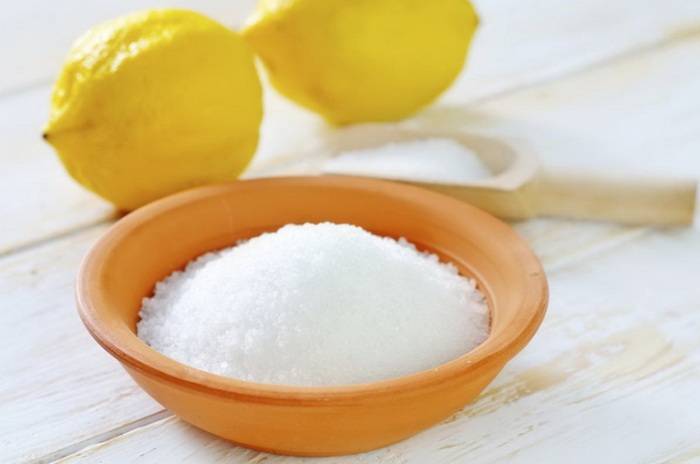
The citric acid helps to remove limescale from the coffee machine on its own.
Rinse the container, pour clean water and turn on the coffee preparation button. Repeat the procedure two times.
What not to do
During the procedure, it is prohibited:
- add water to the hopper if there is no requirement from the machine;
- remove the drip tray, drip tray or brewing unit while the program is running;
- do not turn off the device during descaling (if this function is not provided by the manufacturer).
If everything is done correctly, the coffee machine will function smoothly.
How does scale appear
The equipment must be maintained regularly. Water is a good solvent. Enriched with salts of calcium, magnesium, iron and other impurities, it becomes quite tough. Scale is based on calcium salts, therefore the cleaning process is called decalcification.
> By the color of the sediment on the walls of the apparatus, you can determine the prevailing composition in it:
- off-white color with a yellowish tinge indicates a high content of calcium and magnesium in the composition;
- red color indicates an increased amount of iron;
- snow-white is the most dangerous, as chlorine stains.
Any scale should be removed to prolong the operation of the machine and not harm your health.
Descaling liquid
You can clean the coffee machine yourself.
First, carefully read the instructions from him. If you have lost it, try to find and download it on the Internet. Usually the manufacturer specifies in detail how to properly clean the device. You just have to follow his instructions.
In this article, we present the most versatile ways to clean coffee machines. However, they may differ for specific models.
Liquid cleansing technology is as follows:
1. Remove coffee residues from the filter and container.
2. Prepare the cleaning solution according to the instructions and pour it into the water container up to the max.
3. Turn on the coffee machine and turn on the tap, drain about 150 ml of liquid. Then drain the solution in small portions every 5 minutes.
5. If the device does not have a spray, then at the end of the procedure, when the cleaning solution has not yet ended, add coffee and start the beverage preparation program. When the coffee is ready, continue draining the cleaner. The drink, of course, needs to be discarded.
For horn-type or pulverized appliances, it is possible to run the program without adding coffee.
4. After the cleaning liquid is finished, remove the reservoir, rinse it under the tap and fill it with clean cold water. Now repeat step 3.
5. Rinse the brewing unit of the appliance with water.

Descaling agents
Chemical
They contain acid-containing components. They can only be used for units with a steel, glass or plastic coating. The substances are effective, but the acid negatively affects the automation system, corrodes rubber seals.
Removal of solid deposits is carried out in a room that is ventilated or in which there is a powerful hood. The fight against scale is not only measures to eliminate plaque, but also the prevention of its occurrence.
Softening filters
Effective products that significantly reduce water hardness. Prevents the appearance of plaque. After application, calcium and magnesium ions precipitate and do not reach the surface of the heating components.
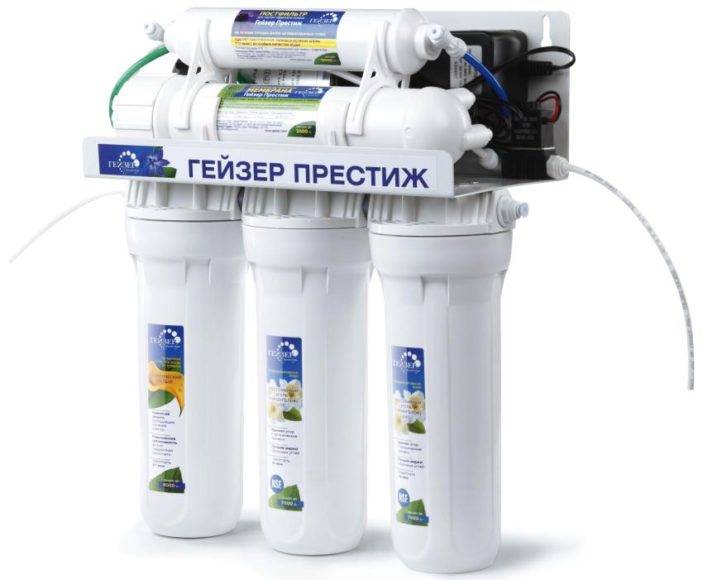
Technological method of protection
This cleaning option has been developed by home appliance manufacturers. The effectiveness of the method in protecting the device from solid deposits, saving electricity.
Delonghi (Italy) has produced a natural-based product Optimal.
The key characteristics of a substance include:
- Effective cleaning of multiple layers.
- In addition to cleaning coffee machines and components, the product removes hard deposits in teapots.
- Lactic acid is taken as the base.
- 500 ml is enough for 5 cleanings.
- The product has been tested and is safe to use.
When cleaning the coffee machine, you must follow the recommendations:
Avoid contact with acid-sensitive surfaces
For example, when the coffee machine is placed on a marble surface, it is important to put a film on top of it before cleaning.
Read the directions for using the product.
The substance should not get on the skin and organs of vision. In case of contact, you must immediately wash with cold water.
Keep out of the reach of the child.
- High efficiency. Many companies buy industrial descaling products at wholesale prices. Buying large quantities is economically beneficial. Substances that have been formulated specifically to break down limescale are indeed helpful in solving many problems.
- Safe influence. Many modern products do not negatively affect aluminum and copper parts. They contain substances adapted for the processing of zinc-coated steel.
- Wide range of applications. The funds are used to clean heat exchangers, condensers, boilers, radiators, heating systems, pumping and other equipment. They are used at energy enterprises, in boiler rooms, etc. They are also suitable for home use.
Cleaning the coffee machine: When to do it?
If your coffee machine runs smoothly - makes no noise, brews on time, milk dispensing goes smoothly - you are very lucky, but there is an exception. it happens that coffee becomes a little sour with some bitter aftertaste, which means that the moment has come when it's time to start cleaning. You are in luck if the coffee machine has a pollution level indicator, but if it is not, then you need to learn to determine it yourself.
Typical signs:
- the taste of coffee has changed;
- there is a residue on the mug after drinking coffee;
- water heating takes longer;
- slow flow of water into the cup;
- unpleasant sound from the coffee machine.
If you have money to spare, then you are very lucky. You can have the coffee machine cleaned by a specialist in the repair of such machines. But if an extra penny is dear to you, you should learn how to clean coffee equipment, especially since it is quite easy and simple.
According to the recommendations of specialists, it is necessary to clean the device once a week if the water is soft. But if the hardness of your water is exceeded, then it should be cleaned every 2.5-3 weeks.
Many modern devices are equipped with special indicators that help to identify contamination. Depending on which icon, you can determine which cleaning needs to be done. One might indicate limescale and the other might indicate coffee oil.
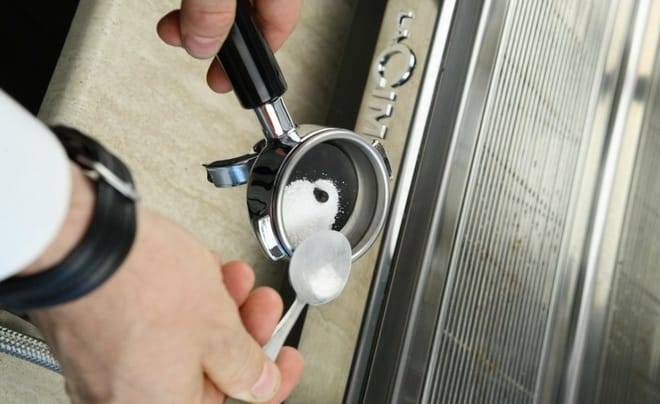
Care and prevention measures
In order for the coffee machine to serve for many years, it is necessary to properly care for it and observe preventive measures to prevent the formation of old deposits:

Descaling tablets for the coffee machine
upon detection of the first signs of scale on the walls of the machine, it is urgent to take care of its elimination with the help of tablets and other means for cleaning the coffee machine with proven effectiveness;
preventive flushing will protect the device from the accumulation of coffee oils and plaque;
the use of built-in filters will help prevent the formation of limescale;
it is important to ensure that coffee grounds do not accumulate in the coffee machine;
it is necessary to regularly remove milky plaque;
it is worth listening to all the provisions of the instructions for use, otherwise the coffee machine may be irretrievably damaged.
Coffee machines must be decalcified regularly. You can remove plaque with the help of chemicals and folk remedies in certain proportions. Many modern devices have a self-cleaning function, which greatly simplifies the life of the owner, but does not deprive him of the responsibility to properly care for the machine and observe preventive measures
Before you clean your Delonghi, Benvenuto, Nivona, Siemens coffee machine, it is important to read the instructions for the device
How often to clean
The frequency of cleaning work depends on several indicators:
- The throughput of the machine per day - if used for home purposes (3-10 servings of coffee per day), then cleaning is necessary once every 2-3 months. In places of public catering, flushing with the use of special equipment is carried out once a week.
- The hardness of the water used - soft purified water practically does not leave scale on the elements of the machine, while tap water contains a large amount of calcifications deposited on the walls of the heating element.
- The presence of characteristic signs of a clogged coffee machine - the cleaning procedure is performed as quickly as possible in order to reduce the risks of failure of the entire coffee machine system.
Expert opinion
Borodina Galina Valerievna
Some devices are equipped with sensors that remind you to clean. If this is not the case, then you need to follow the instructions, where the manufacturer gives recommendations regarding the frequency and frequency of cleaning.
Cleaning the coffee machine with citric acid

We still recommend using special tools: it is safer and safer. However, if you decide to use the folk method, then here is the instruction.
The cleaning process will take no more than 30 minutes and will consist of 3 stages: descaling and two rinsing cycles.
So, let's get down to descaling:
- Make sure there is no coffee or used capsules left in the machine.
- Remove the water tank and rinse it well.
- Pour 1 liter of water into a container, add 30 g of citric acid.
- Wait until the granules are completely dissolved, then put the compartment back in place.
- For a device with a self-cleaning function, it will be enough to start this program and wait for it to end. If the coffee machine is of a simple model, then we use the manual cleaning method. But first, wait 15 minutes - this time is enough for the substance for active work. Start a coffee preparation program. Repeat this until all the liquid from the reservoir is used up.
- Unplug the device from the mains, remove the container for washing.
- When the descaling procedure is completed, the first rinse phase begins. Fill the tank with clean water up to the maximum mark. Replace the drawer and turn on the brewing mode.
- For the second rinse cycle, remove the container, rinse and refill with water. Return it to the car. Start the coffee program until the tank is completely empty.
Some tips for use
- It is better not to experiment and not select the supposedly suitable products for the coffee machine yourself. When buying a device, be sure to check this question with a sales assistant and do not forget to study the instructions.
- Clean every week or every 2 weeks, depending on the quality of the water and the frequency of preparation.
- You can descale the machine with both branded and universal products.
- Drinks with coffee from a freshly cleaned coffee maker are very tasty and aromatic.
- Use clean water at room temperature for cleaning.
Long and delicious work for your coffee makers!
Tips from experienced housewives
Do you often need to descale?
Constantly! Periodically
- Filtered liquid must be used to prevent scale build-up. And when using tap water, settle for several hours.
- The water poured into the container should not be boiled more than once.
- As a prevention of the appearance of powerful scale, a simple manipulation is performed: when boiling water, once a month, 1 tbsp is poured into the container. l. citric acid.
- By using simple cleaning methods for home appliances, you can permanently get rid of problems with scale build-up. If you remove solid deposits in time, then you can exclude their accumulation on the walls.
Cleaning the coffee maker
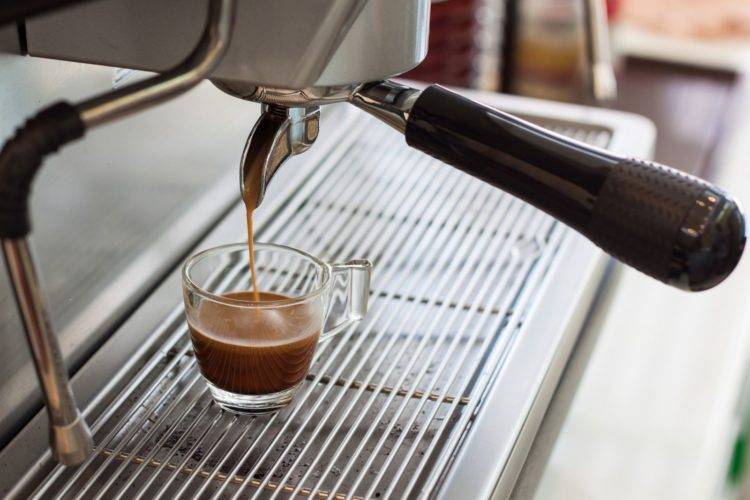
Horn-type devices. There is a special brewing compartment here.During operation, the element retains sediment and coffee oils on the walls. In such devices, the horn is considered the main part (it is responsible for the functioning of the varovik).
With a removable block. Remove the removable compartment and rinse with water. After flushing, you need to put the part back in place. The cleaning procedure is performed every 3-4 weeks.
With built-in steam engine. In such devices, cleaning is carried out automatically. For this, the agent is used in the form of tablets. If the device is misused, it will soon stop working.
The cleaning process is carried out in eight stages:
- Remove the coffee from the steam engine.
- The product must be placed in the ground bean compartment.
- Pour 2 liters of water into the apparatus.
- We set the cooking mode.
- We set the capacity under the nose of the distribution.
- In the setting mode, select the maximum volume.
- Pour out the cup with liquid.
- At the end of the procedure, the device should stand for thirty minutes.
- After the expiration of the time, the apparatus is washed out.
Home remedies for cleaning the coffee machine
Some experts argue that you can use handy tools such as cola and vinegar to clean coffee machines. Experts say that such a method will have a bad effect on the device. It is necessary to use special cleaning agents, citric acid is also suitable from home options.
Cleaning the coffee machine from limescale with citric acid is a fairly effective method, as well as safe. The substance has absolutely no harmful effect on the human body, unlike household chemicals that are used in everyday life.
The process of descaling a coffee machine using citric acid:
- Disconnect the device from the power supply.
- Pour 1 liter of water and 4 tsp into the bowl. citric acid.
- Wait for the powder to dissolve.
- Switch on the coffee machine and press the automatic cleaning mode.
- The solution must be completely consumed, otherwise it can enter the human body.
The second stage is rinsing. It is necessary to rinse the coffee maker well from the residues of the product.
The third stage is a secondary rinsing with water. Fill the tank full of distilled liquid and start brewing coffee. Try to empty all the water by passing it through the machine.
Citric acid is suitable for all appliances. It does not spoil the internal elements of the device and is cheap in terms of the price category. Previously, there were no cleaning products on the farm, which now overflow store shelves. People had the opportunity to use citric acid. Soon, advertising drove us to a dead end, and now few people remember how effective the cleaning method with citric acid is.
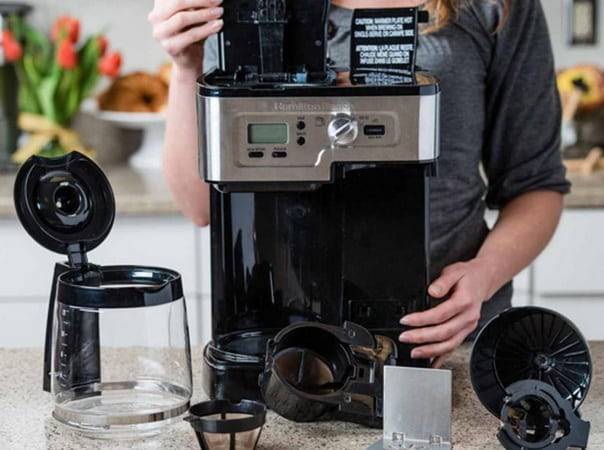
How to clean a cappuccino maker
The cappuccino maker requires regular cleaning of milk fat. If you do not carry out the procedures, the device will give off a rather unpleasant odor. Milk fat often settles on the tube walls. If the milk compartment is removable, it will be much easier to clean, as you can visually assess the presence of a greasy layer.
If you have a built-in model, then you need to use professional tools and carry out with the frequency recommended by the manufacturer.
The coffee machine does not form a tablet - the main causes of the malfunction
Clearly formed tablets will flow into the waste coffee container when working properly. If there is some deviation from the norm, then something is wrong with the coffee machine and you need to look for a problem. It is likely that the reason could be exploitation. Then it is not necessary to involve specialists. You can customize the system yourself.
Many parameters can affect the durability of the tablet: grade and grinding of grains, amount of water, strength level.
One of the reasons the tablet may be liquid is the wrong setting for the selected coffee beverage. You may be preparing a large amount of espresso in one shot. This is very bad, because after spilling a certain amount of water, bad fractions begin to flow.If you want to make a large volume of any beverage, it is better to make a double espresso or Americano.
Another reason is the wrong choice of the degree of grind. The tablet may not form well if the grind is too coarse. Such coffee can be prepared in a Turk, so as not to clog the horn. This moment is provided in modern coffee machines. Manufacturers include 8 adjustable grind levels. If you find it difficult to decide, choose - medium.
What makes the coffee machine dirty?

There are two types of device contamination:
- Stable plaque from calcifications - formed by heating water rich in calcium ions. Scale accumulates mainly on the water heater, but can fall off over time and clog other parts of the coffee maker.
- Coffee Bean Oil - During the grinding and brewing process, an oily coating forms that cannot be removed with plain water. Plaque accumulates, which negatively affects the taste (there is a taste of rancid oil).
Even the most careful users, who wipe every drop and clean all filters after each use, face contamination problems. The operation manual indicates the need for preventive cleaning, the absence of which will immediately appear on the operation of the coffee machine.
Use for coffee machine, kettle with various coatings
Made of plastic. Do not clean with vinegar. Instead, citric acid can be used at the rate of one bag per liter of water. When the acid has dissolved, the water is brought to a boil. The walls of the kettle are not cleaned immediately. After the first time, the boiling procedure is repeated again. You can boil the kettle 2 more times.
Made of stainless steel. For a device made of this material, you need to use a bite. You can take apple cider vinegar and dilute it one in nine. The liquid can be poured into a container and sent to the fire, boiled. Then shake the liquid and check if there are still traces of scale. After boiling, you can put the device aside for a while and wait for the scale to peel off. Next, wash off the remaining vinegar with water.
From ceramics. You need to clean the devices in stages. Initially, 2 tbsp is poured into 500 ml of water. l. soda. The solution must be boiled. The boiling process should last no more than half an hour. Then the liquid is drained and 20 g of citric acid is added to it. Pour the mixture inside again and bring to a boil. Usually, after 2 boils, the plaque disappears. Large residues can be removed with a regular dishwashing sponge. If the scale is outdated, then it can be cleaned out in 2-3 times.
Electric. If this is an electrical appliance, the basis of the material of which is plastic, then vinegar will not work here. A metal device can be cleaned with a vinegar solution, which is prepared with 500 ml of water and 200 ml of vinegar 9%. The product must be poured into the device and brought to a boil. When boiling the cleaning agent, the lid must be slightly opened. This way you can see if the remedy is working.
Special products - decalcifiers
Special cleaning agents will help to cope with the prevention of limescale. They provide high quality and professional care for coffee machines and coffee makers.
Eco decalk
The original concentrate decalcification liquid that removes limescale the first time. It is a natural biodegradable raw material that does not pollute the external environment.
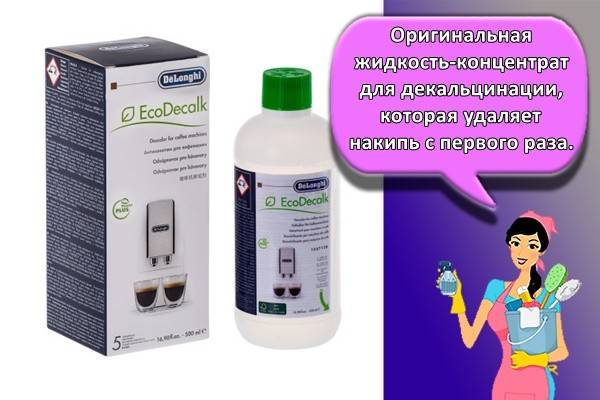
The product should be used according to the instructions. For effective cleaning, it is enough to dilute 125 milliliters with 1 liter of water.
SER3018
The ecological product is designed for 4 procedures. The liquid is popular as it is suitable for all models of coffee machines: manual and automatic. After cleaning the device, it is imperative to rinse the machine, wash out the remains of the product.
Lemon acid
Citric acid is an effective and cheap decalcifier. A large number of branded products are based on this particular product.
Benefits of using
Citric acid is not harmful to the human body and animals.
The main advantages of this raw material for decalcification include:
- ability to gently remove sediment;
- clean off old scale;
- lack of toxins;
- is cheaper than expensive cleaning products.

In addition, the product is almost always at hand in the kitchen. It can be purchased at any grocery store.
Cleaning instructions
You need to organize care only after studying the instructions from the manufacturer. It describes acceptable methods, taking into account the characteristics of a particular coffee machine model. The main enemy of every coffee machine is scale. If you use only filtered water, this does not insure you against problems associated with scale formation.
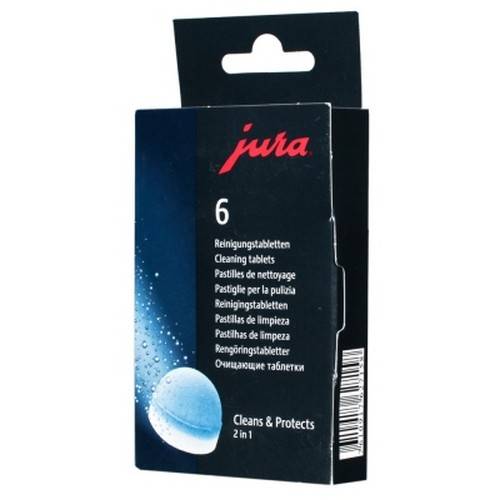
Jura tablets
Failure to clean in time will result in longer coffee preparation, noisy operation of the device, wasteful energy consumption and sudden breakdowns. It is far from necessary to regularly give the device for service. A line of special tools will help to cope with constant maintenance. These are tablets, powders and liquids for cleaning coffee machines.
Appliances with a self-cleaning function can be kept in good condition by periodically applying the automatic program. Start the coffee machine, wait until warming up and press the RINSE button. After rinsing, start preparing the drink. The frequency with which this program is started depends on the intensity of use of the coffee machine.
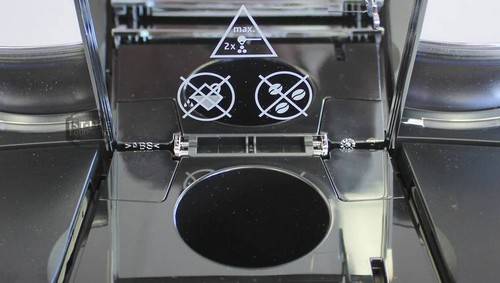
Where to put the pill
Features of cleaning a drip coffee maker from scale
The appropriate way to clean the coffee machine depends on the design and operation of the machine. Steps for cleaning a drip coffee maker:
- wash the filter with warm running water with a delicate brush and reinstall it;
- mix a solution of 4 tbsp. water at room temperature and 40 g of citric acid in granules;
- pour liquid into a container for water, add cold water until the maximum allowable mark is reached;
- turn on the boiler for about a quarter of an hour, after half an hour do it again and wait until all the liquid base passes into the receiving container;
- if residues of deposits are found on the filter, it is worth lowering it in a hot solution of citric acid and leaving it for about an hour;
- rinse the filter well;
- repeatedly pass clean water through the device until the acid is completely released.

